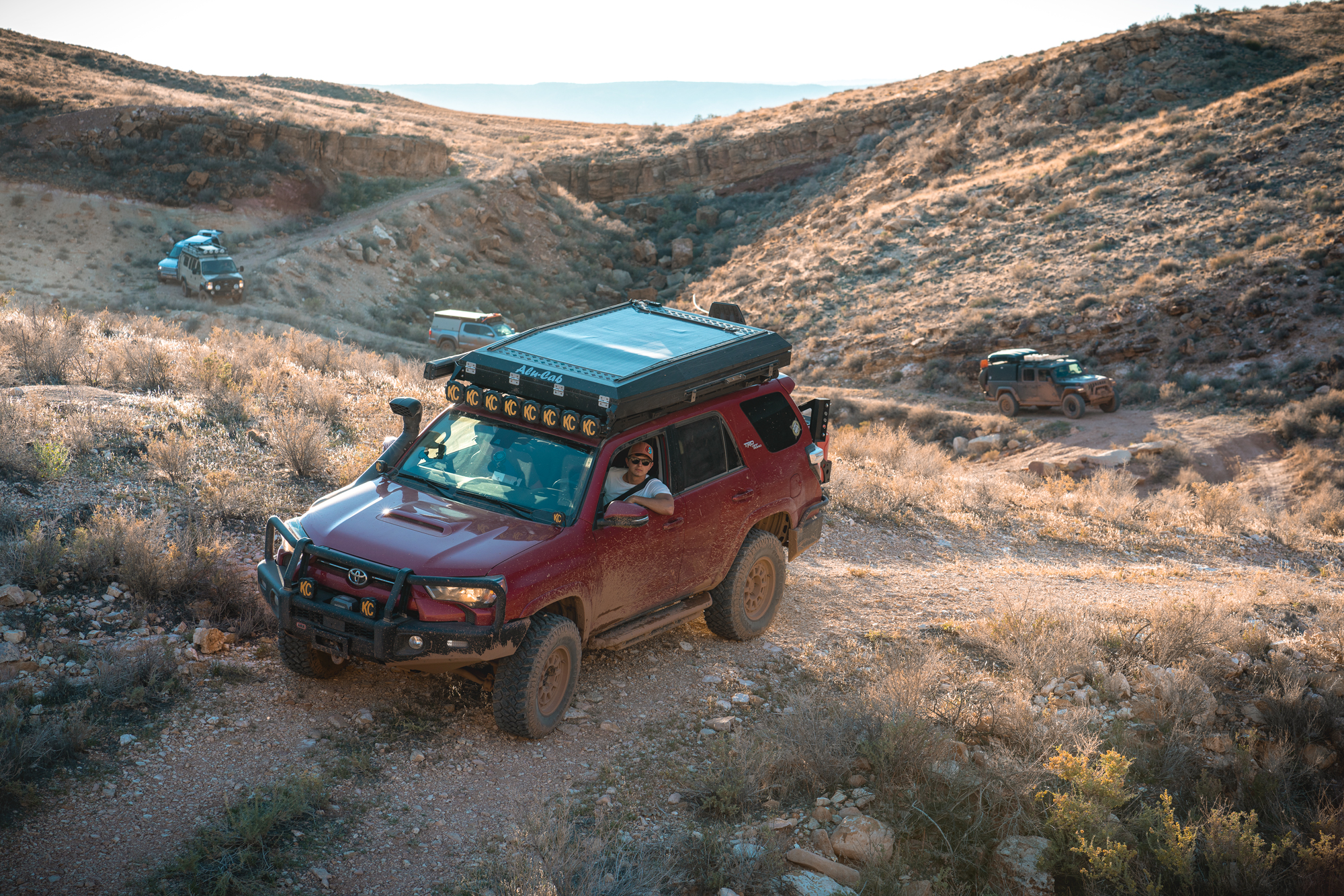This 36 Hours of Adventure is Presented by:
Red sand clings to the deep treads of our Defender as it slowly claws its way up a steep, rocky stretch of trail above the ghost town of Grafton. We’re just outside St. George, Utah.
Originally homesteaded in 1859, Grafton’s population topped 168 individuals at its peak. Today, a handful of the original Mormon-built structures—a church, a log cabin, and a few other outbuildings—remain intact, thanks to preservation efforts by the local historical society.
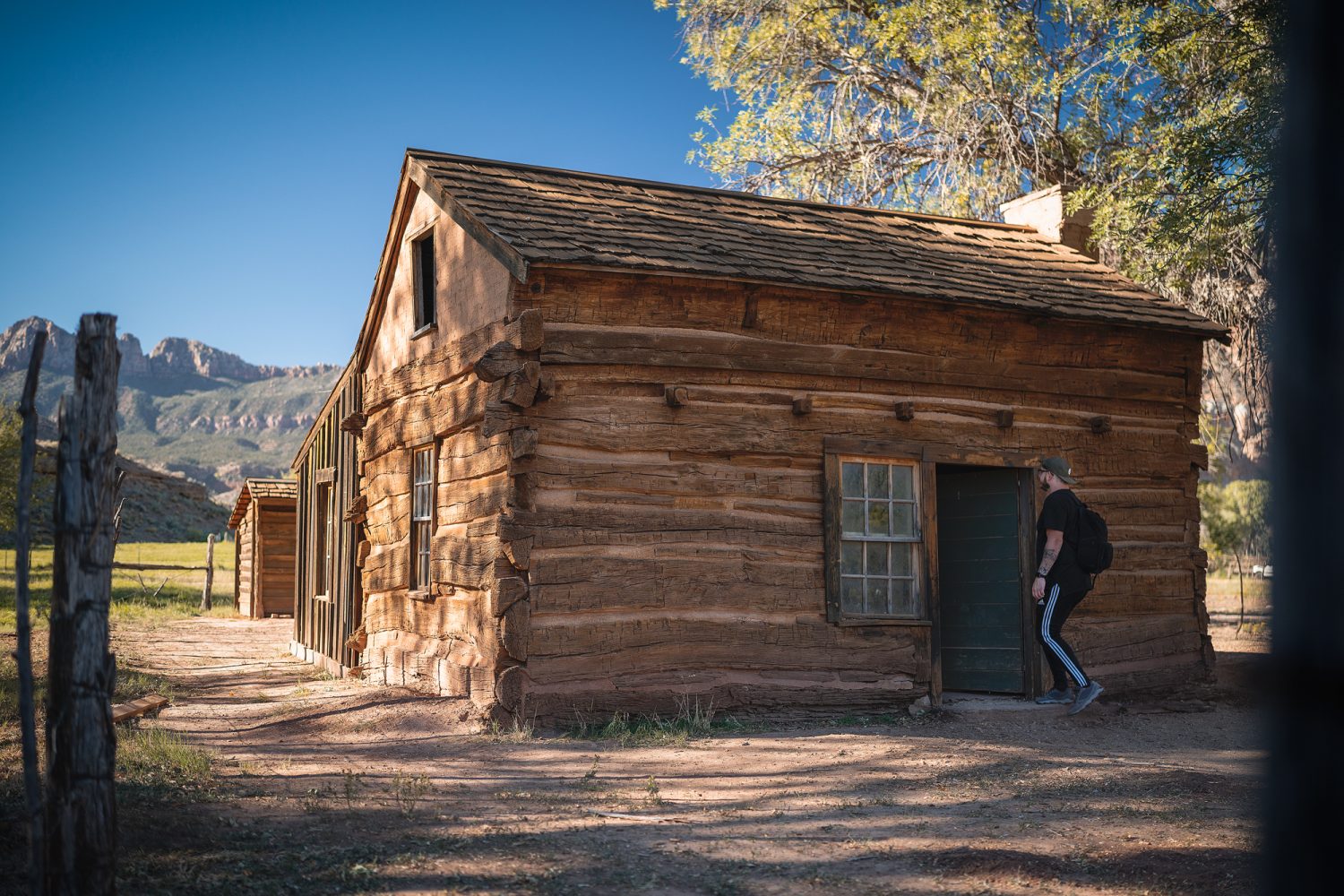
Exploring the ghost town of Grafton on our way to the North Rim of the Grand Canyon.
The rustic pioneer buildings are exactly what you’d imagine: unfinished sun-baked cottonwood boards, the edges of which are weathered and curved outward from a century of exposure. Ducking through low doorways, I picture the humans that lived here and how they must have been smaller back then, whittled down to their essential form by this harsh desert. That or they were just content to have a roof (of any height) over their heads. High ceilings require more effort to heat anyway.
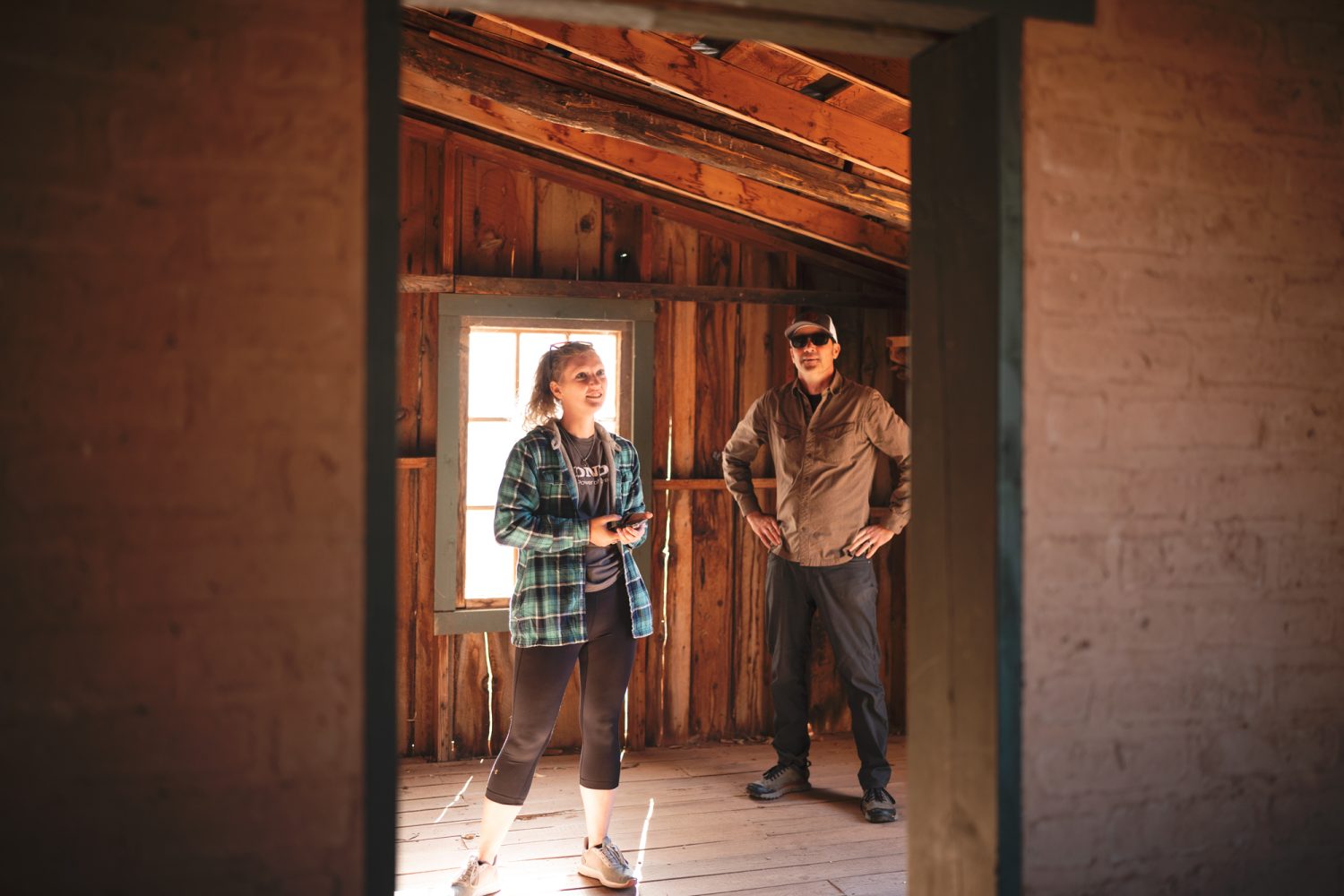

Walking away from the buildings, our group’s focus shifts back to the convoy of a dozen overland vehicles parked along the sandy road in the shade of the fluttering cottonwood leaves. Whereas the pioneers of this valley relied on their horses, we rely on horsepower. Our vehicles, unusual as they may appear to the average motorist, are purpose-designed for off-highway travel. Each has a variety of extra bits (overland equipment) bolted to roof racks and tailgates. Rooftop tents, Hi-Lift jacks, jerry cans, sun awnings, and shovels fulfill a variety of purposes, from providing comfort in camp to helping us recover vehicles if they become stuck or disabled on the trail.
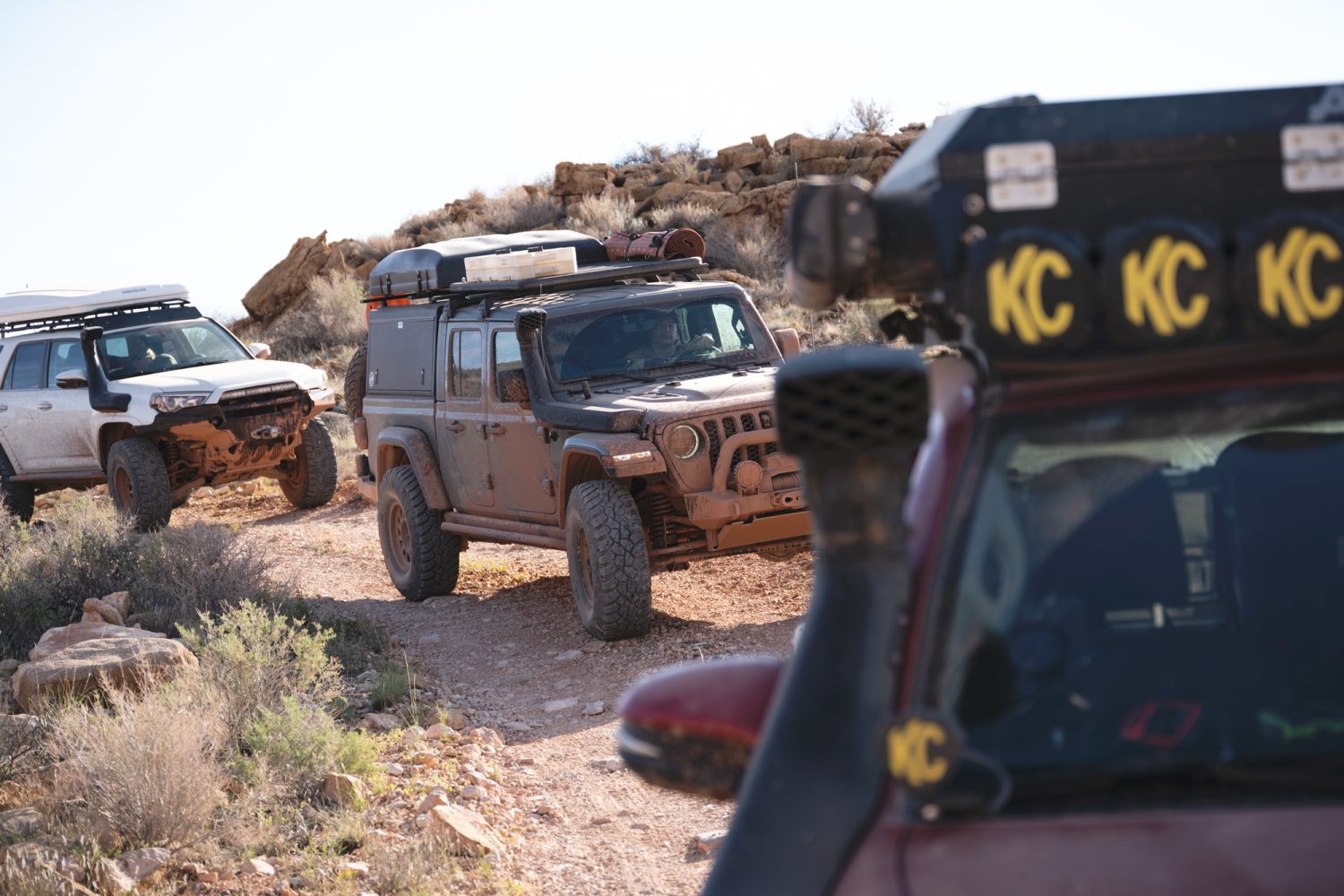
Our convoy of overland vehicles.
We’re a small group of journalists being guided on this overland journey by some legends in the industry. For instance, one of our trail guides, Jim West, took second place in the 1992 Camel Trophy race in Guyana. Jim went on to help pre-scout and develop the race route in ’94. He also helped train every US team that participated in the international spectacle of off-road adventure travel from ’93 to ’98.
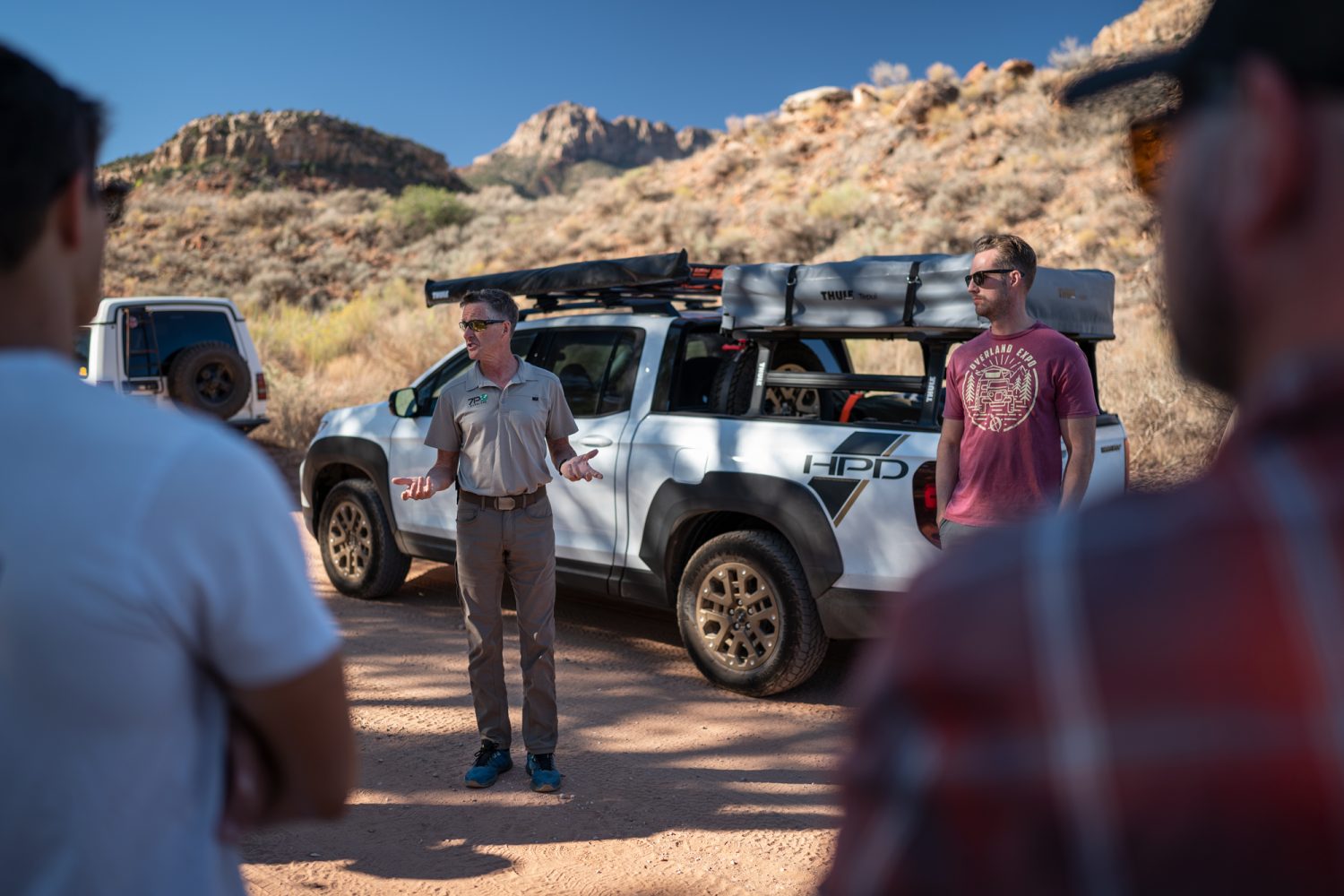
Jim West discusses some driving considerations for the trail ahead.
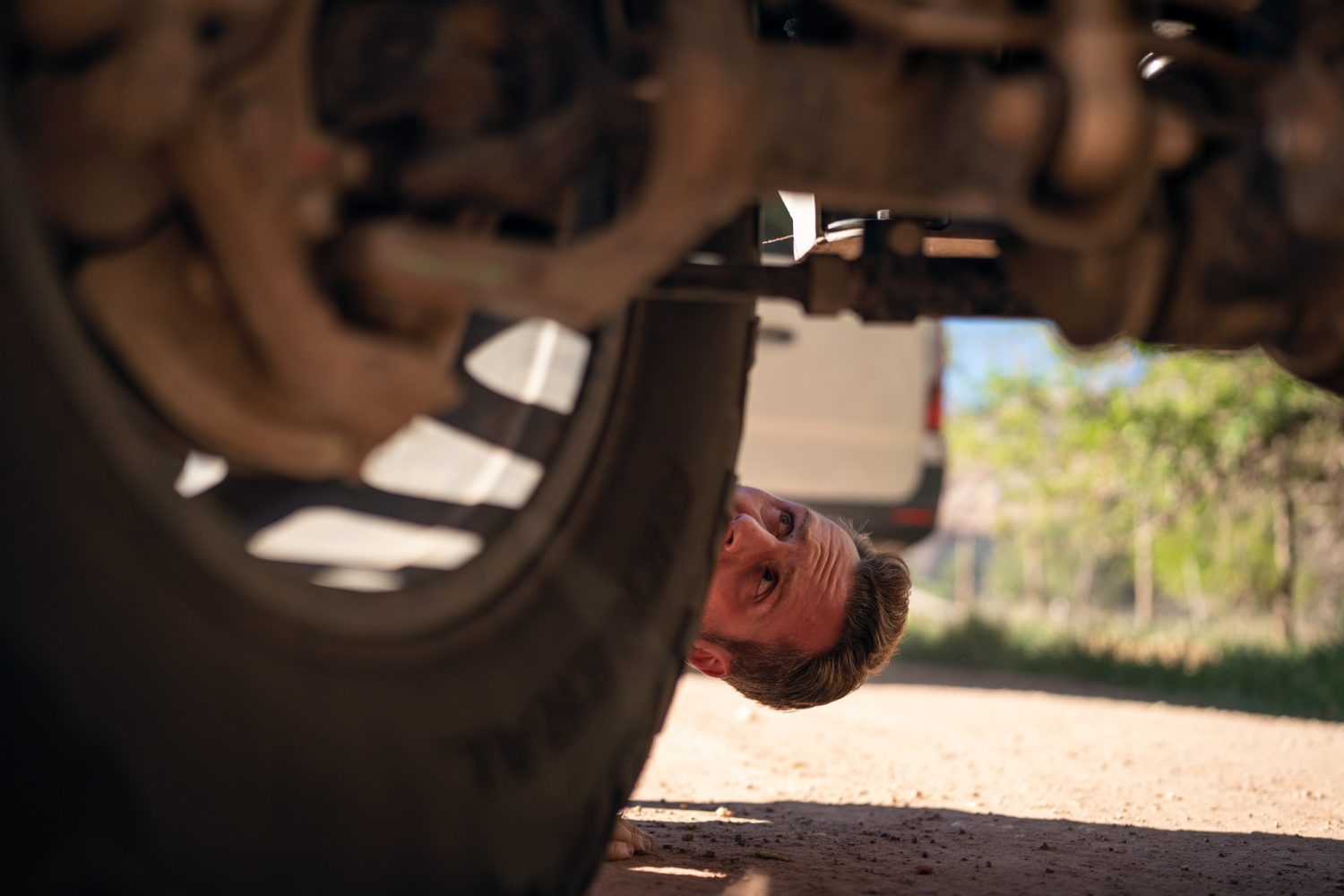
Plenty of ground clearance.
We’ve also got Christopher Walker with us, the founder of Overland Training Canada (British Columbia). In addition to providing professional off-road driver training, vehicle recovery, and expedition consulting, Chris is a former pro-white-water kayaker and is the lead trainer for snowcat operations at Whistler Blackcomb Ski Resort. In short, our trip is being led by some incredibly experienced and accomplished adventurers, and we already feel inspired, despite the fact that we’ve only just left the pavement.
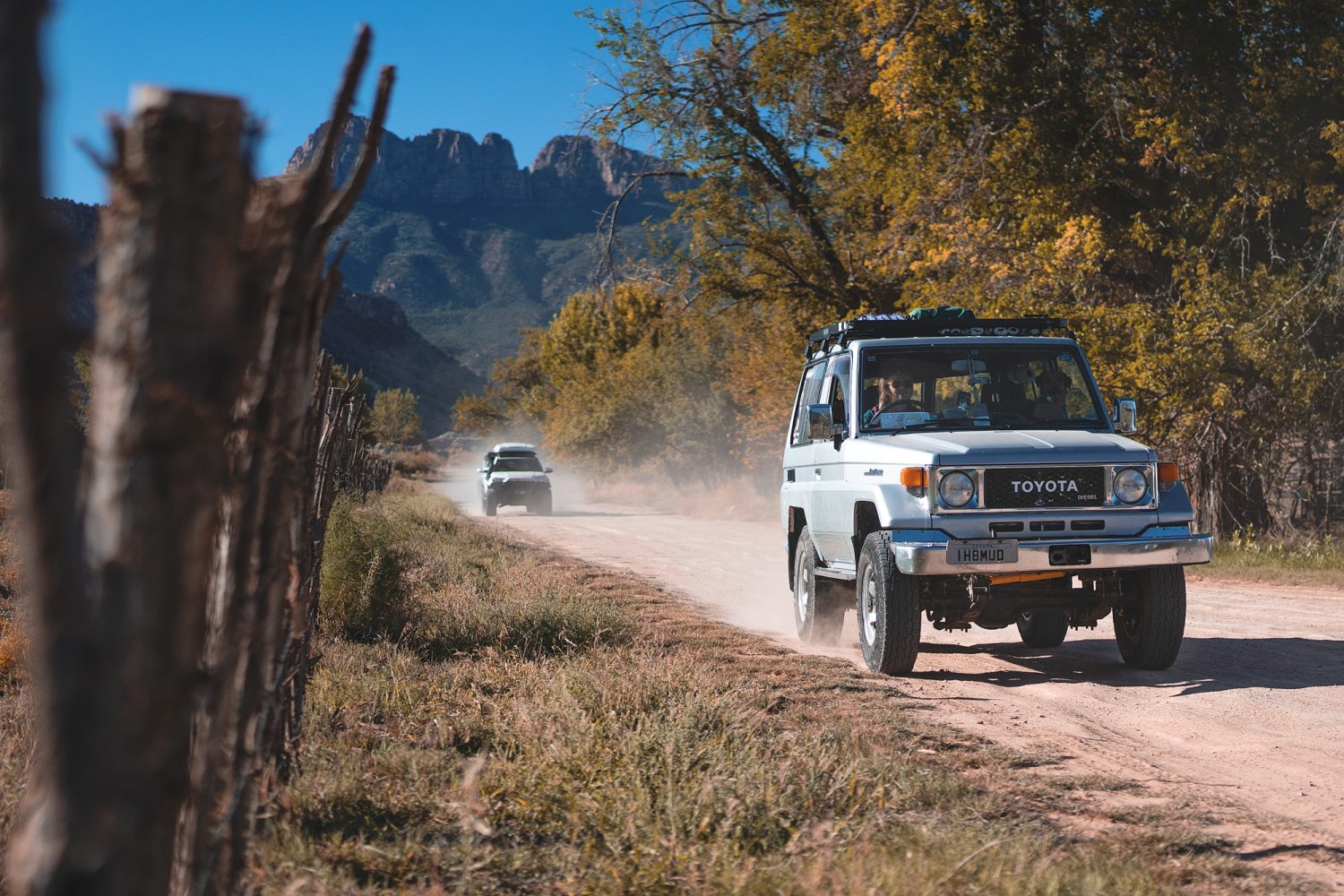
Nothing like a right-hand-drive diesel Toyota!
Our drive continues, and the grade eases, although to be honest, this trail is fairly tame by off-road standards. But it’s not necessarily a technical challenge that our group is after. The point of overland travel, if there is a point (and if I can generalize), is to use our vehicles as a means to have an adventure. Inevitably, a major part of the overland experience entails our time behind the wheel. But more significantly, it’s about the destinations we can access and the incredible things that we get to see along the way.
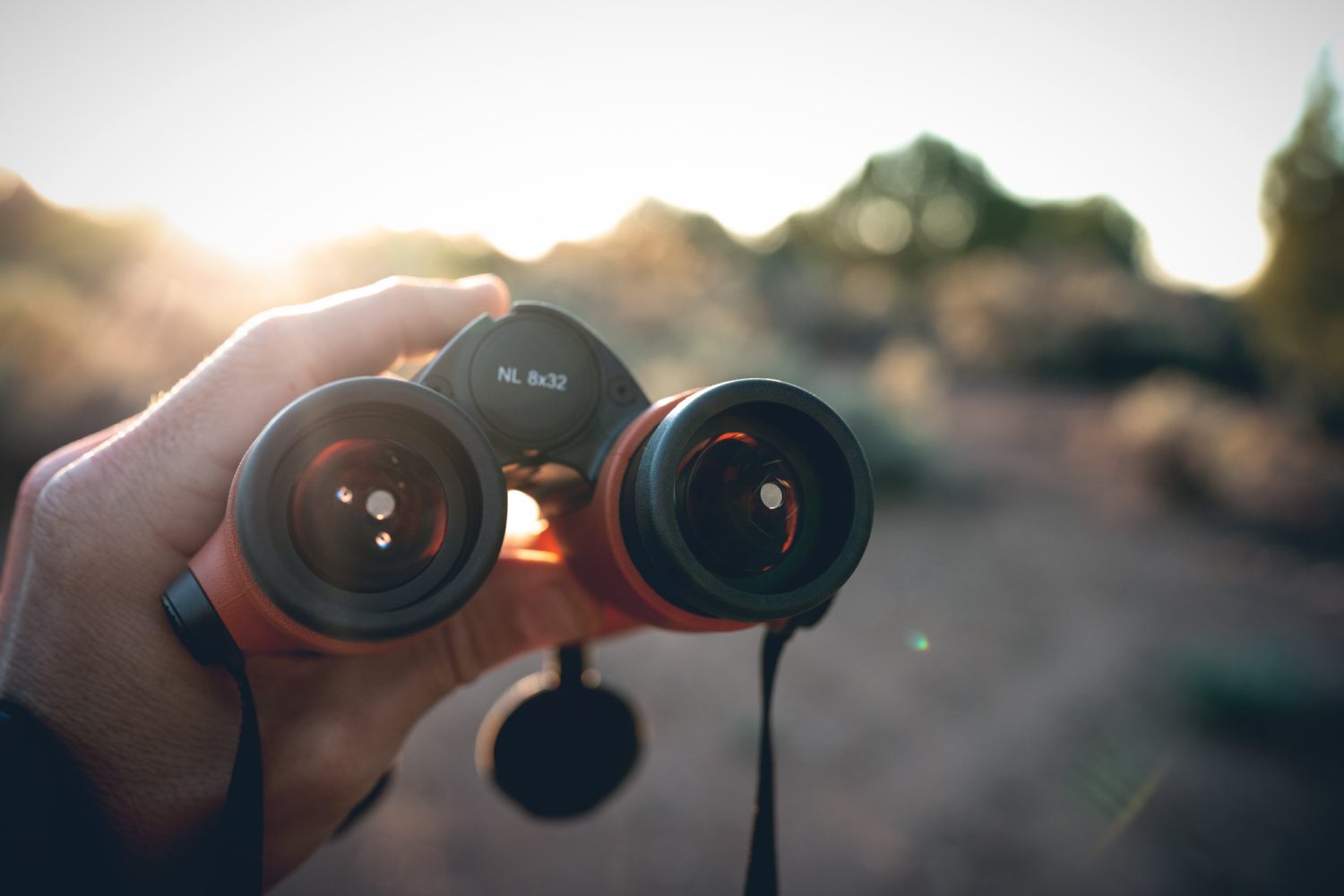
Binoculars are a valuable addition to the overlanding kit.
I see Ben glancing through his trail-worn binoculars toward a blank horizon, and I’m intrigued. We’ve stopped on the trail again, this time to water some shrubs and grab a snack. Dried plant life crunches under my feet as I approach Ben, but before I can ask, he passes the binoculars to me and gestures in the direction he was looking. “Hawks and vultures migrating,” he announces. Ben works for Swarovski Optik. He’s an avid birder, and he’s been kind enough to bring some extra pairs of the Austrian binoculars along on the trail for us to use.
It takes me a few seconds to adjust the diopter to account for the astigmatism in my right eye, but once I get the focus correct, I can see them. There are 20 or more raptors of varying sizes, circling together in a thermal, high above the sagebrush and juniper. It’s amazing how sharp they are through the eyepieces, almost like I’m right there, flying with them. “How did you know they were there,” I ask, still glancing at the phenomenon. “There are a lot of interesting things to see,” he says, “you just have to keep your eyes and ears open.”
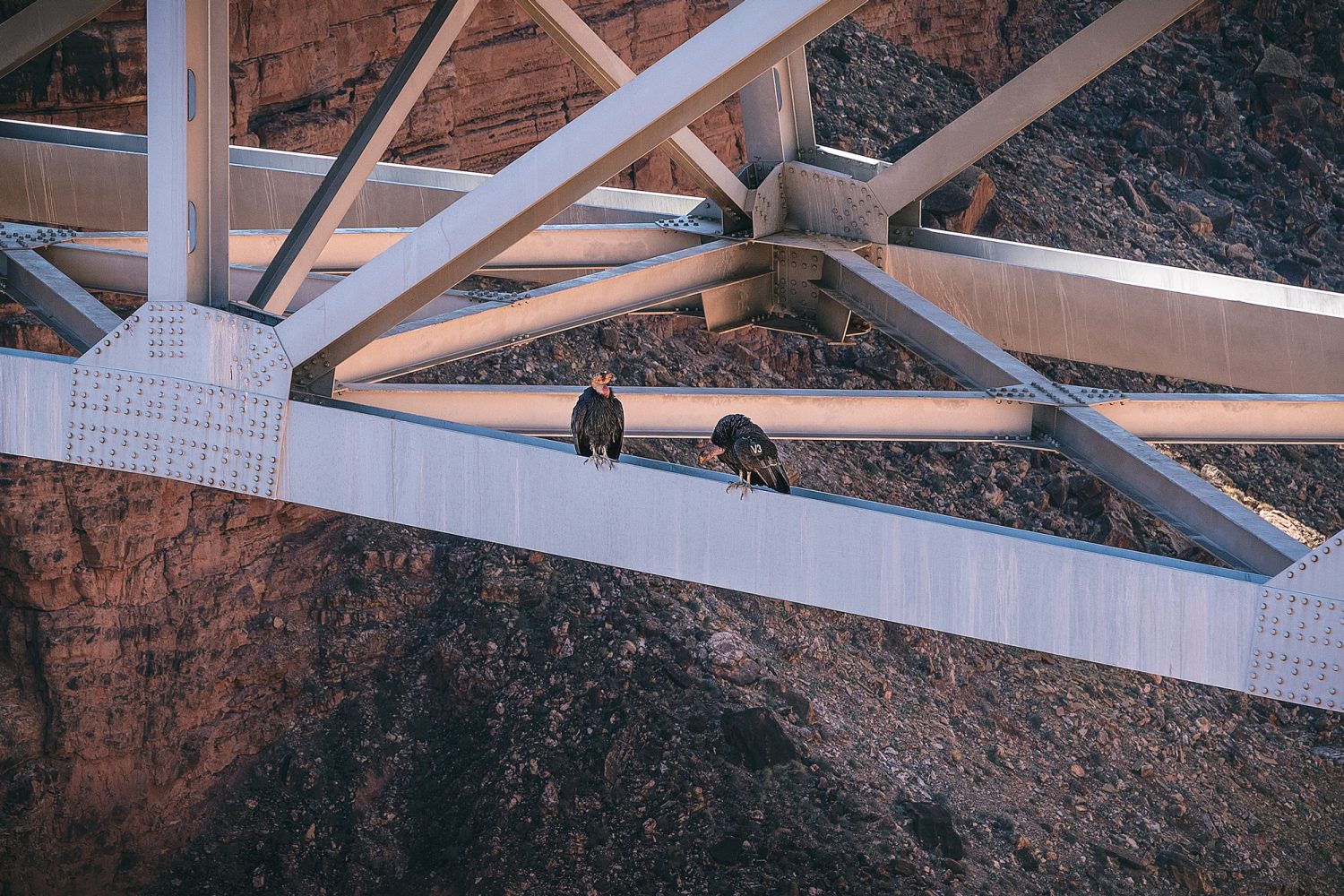
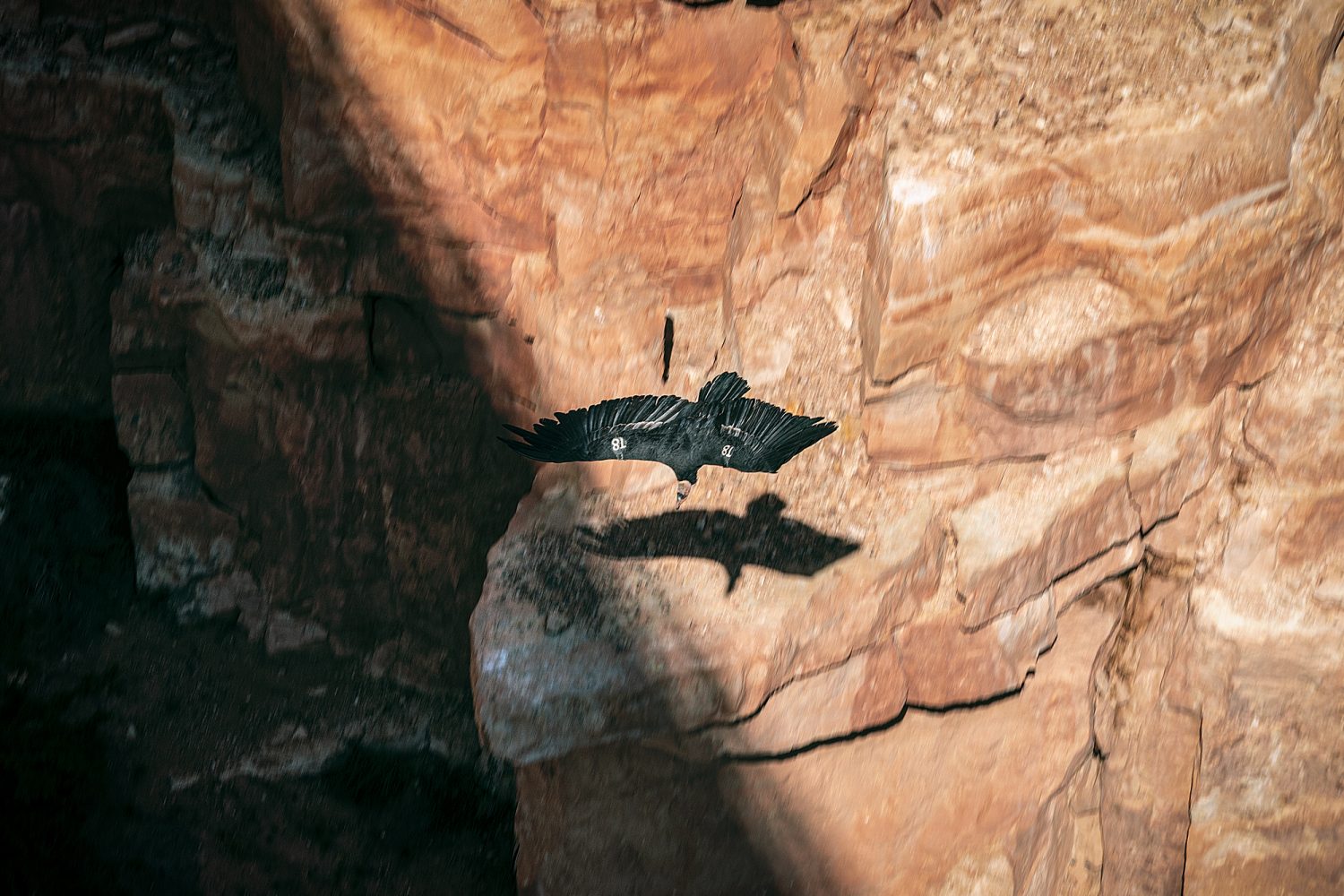
Chance spotting of some tagged condors!
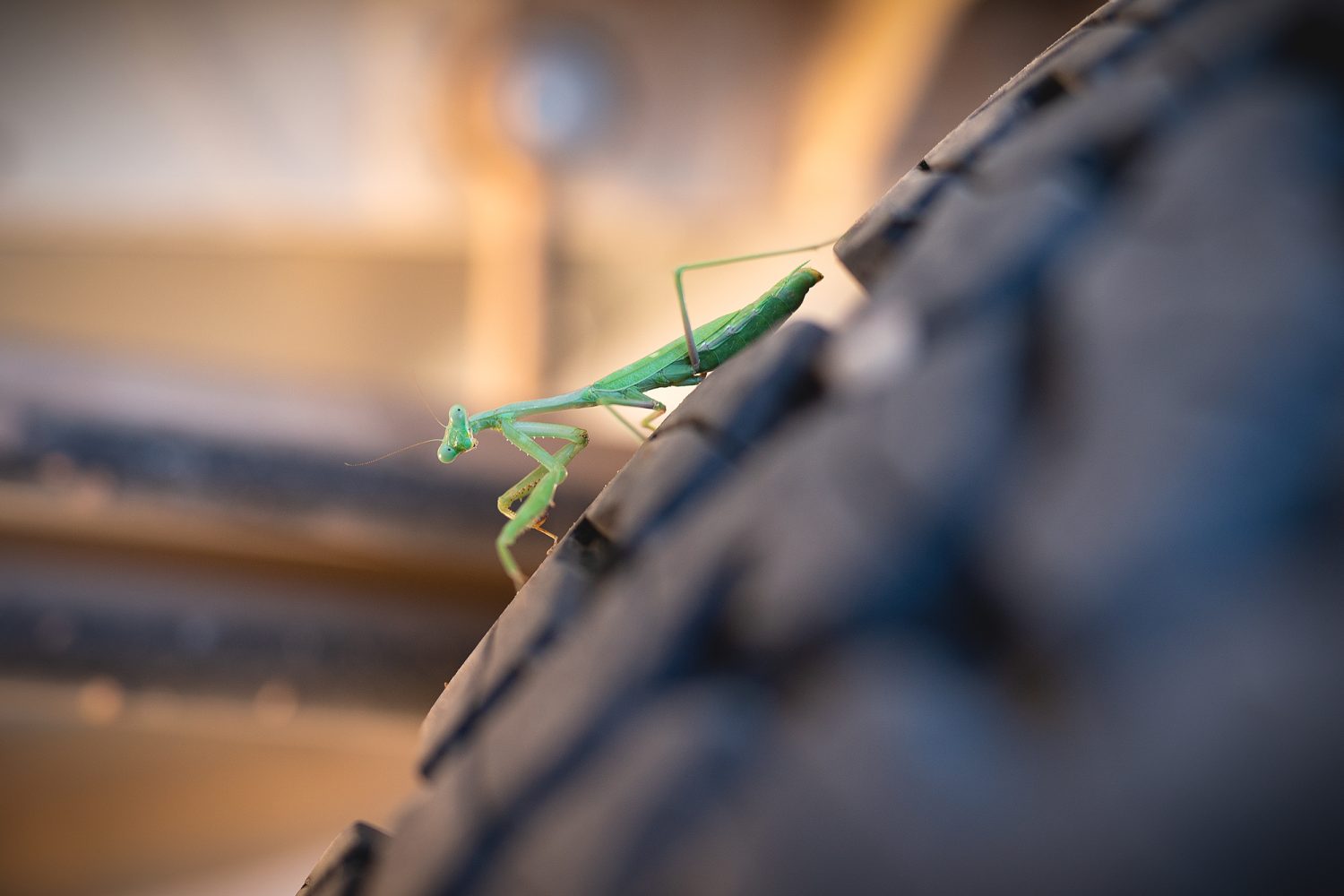
I carefully removed this hitchhiker from my tire before continuing the drive.
Ben’s advice is not lost on me, and in fact, my past as an interpretive ranger taught me the same thing. It’s why it’s important to pause every now and then—to take in the silence and to observe your surroundings. And as you can imagine, it’s much easier to use your powers of observation if you park your vehicle, turn off the engine, and get outside.
Despite the stark and sterile appearance of this high-desert landscape surrounding us, it’s clear that there is more out here to see than meets the eye. At this moment, I make a promise to myself to be more aware of my surroundings and to look a bit closer at the details, lest I miss some excitement because I was too busy playing with my vehicle’s stereo.
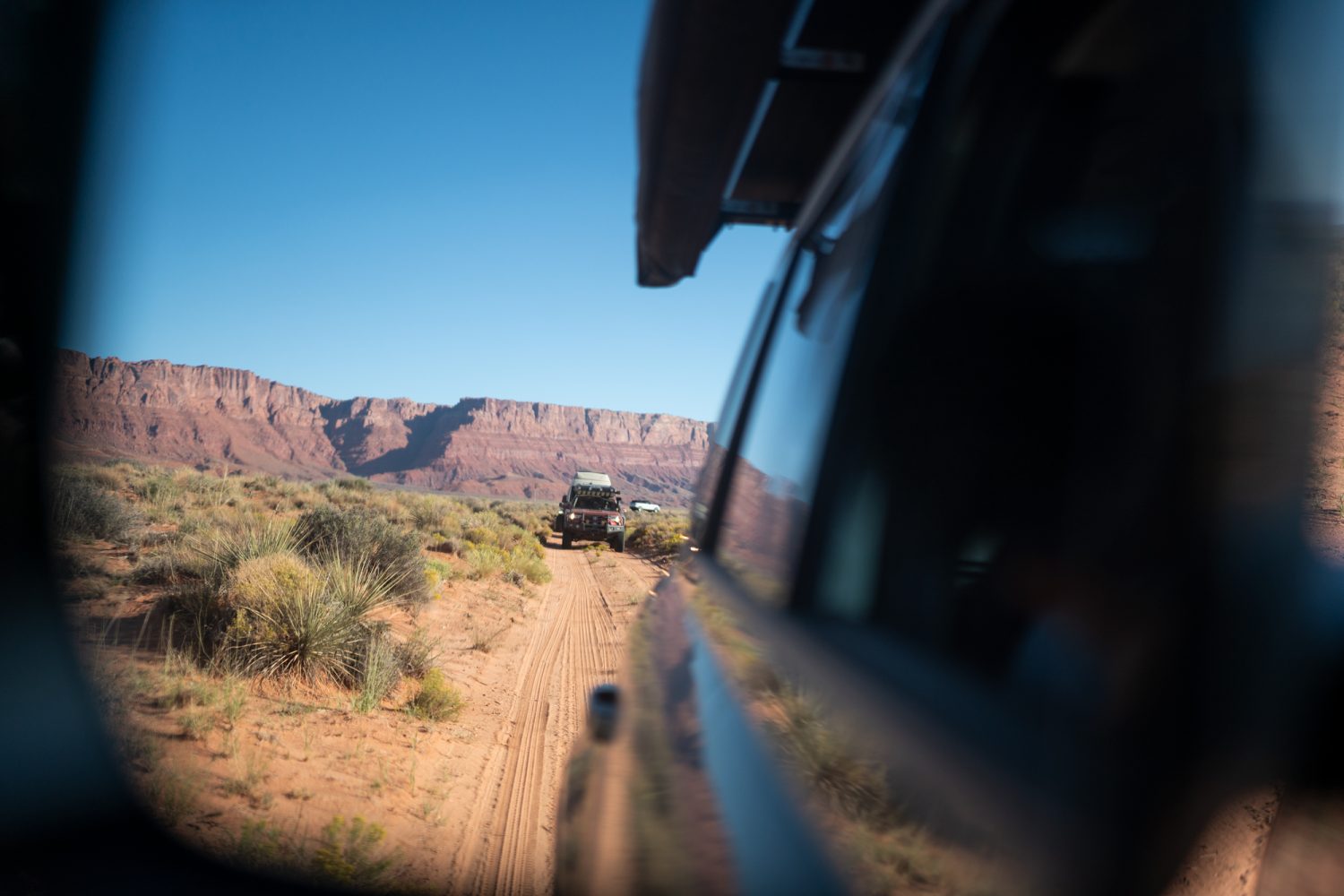
Open stretches of sandy terrain en-route to the North Rim of the Grand Canyon.
More miles of gravel and sand roll past, and our group has arrived on the edge of a wash below a landscape of rolling hills and sharp plants. I was instructed to bring some sturdy footwear on this adventure, but I’m still wearing sandals when the first needle pierces my skin. Yahhhhhh! I quietly exclaim. It’s a familiar feeling, although one I can’t say I’ve grown to appreciate. Glancing down at my bare toes, I can see the tiny translucent spines glistening in the afternoon sunlight. Cautiously, I crouch down and begin plucking.
With the spines removed, I do a kind of skipping, lunging dance back to the Subaru I was driving, careful to avoid getting stabbed again. Sitting in the vehicle with my feet off the ground, I carefully inspect my toes once more before thrusting them into a pair of leather hiking shoes.
In any type of hostile environment, like this desert, or the jungle of the Amazon for that matter, having the right equipment is a crucial part of staying comfortable and safe. And this is one of my favorite things about overland travel (unlike backpacking): using a vehicle to get around allows you to bring everything, including the kitchen sink. I’m not joking. Jim and Chris have it set up under the awning. We wash our hands and eat lunch in the shade.
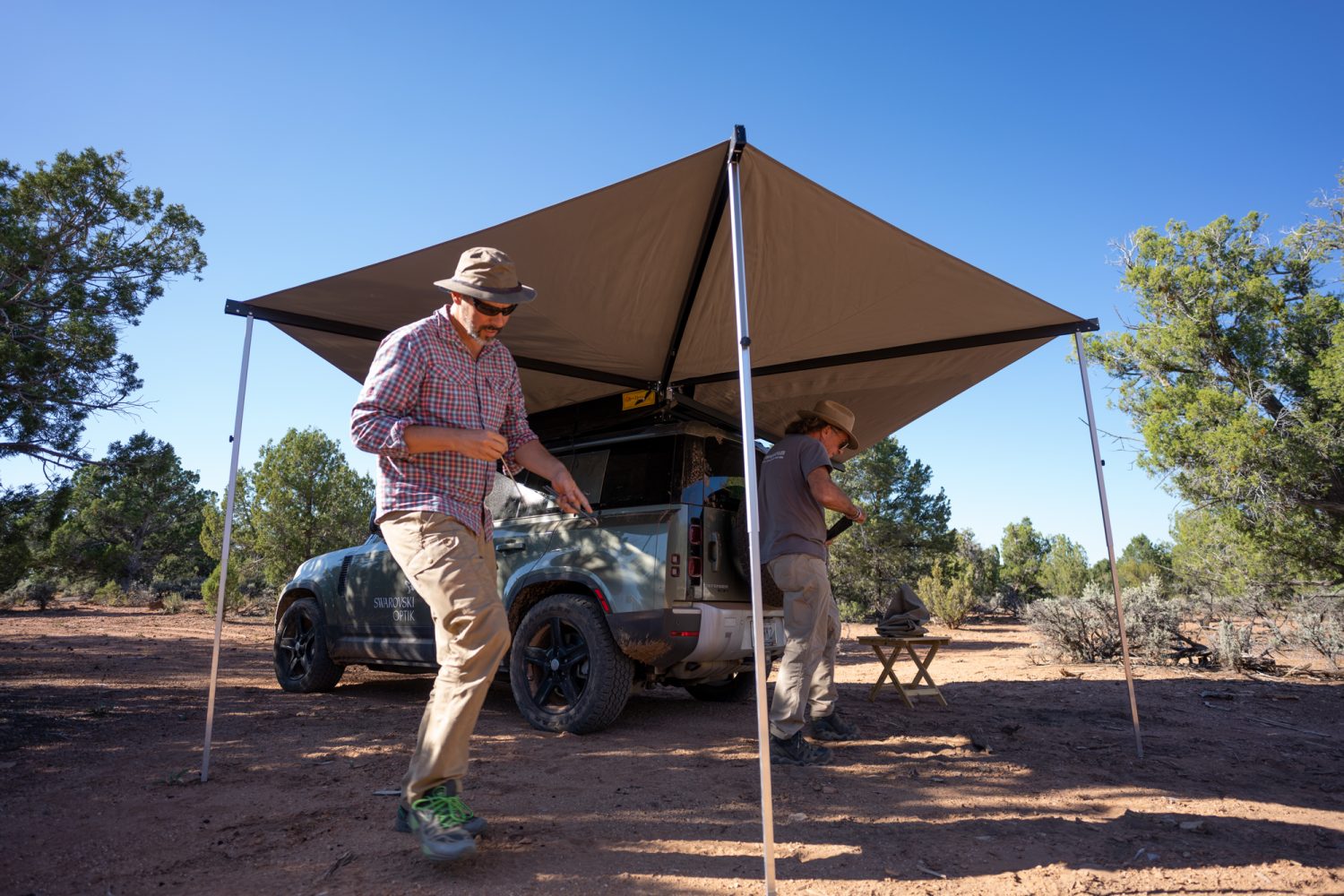
I would consider a vehicle awning crucial equipment for a desert outing.
After lunch, I swap vehicles, jumping into the seat of a Jeep Gladiator with enormous tires. The contrast between this and the Subaru is almost comical, but at the same time, it’s a great reminder that overland adventures can be had in just about any vehicle. Of course, it’s best to tailor your objectives to your car or truck’s capabilities.
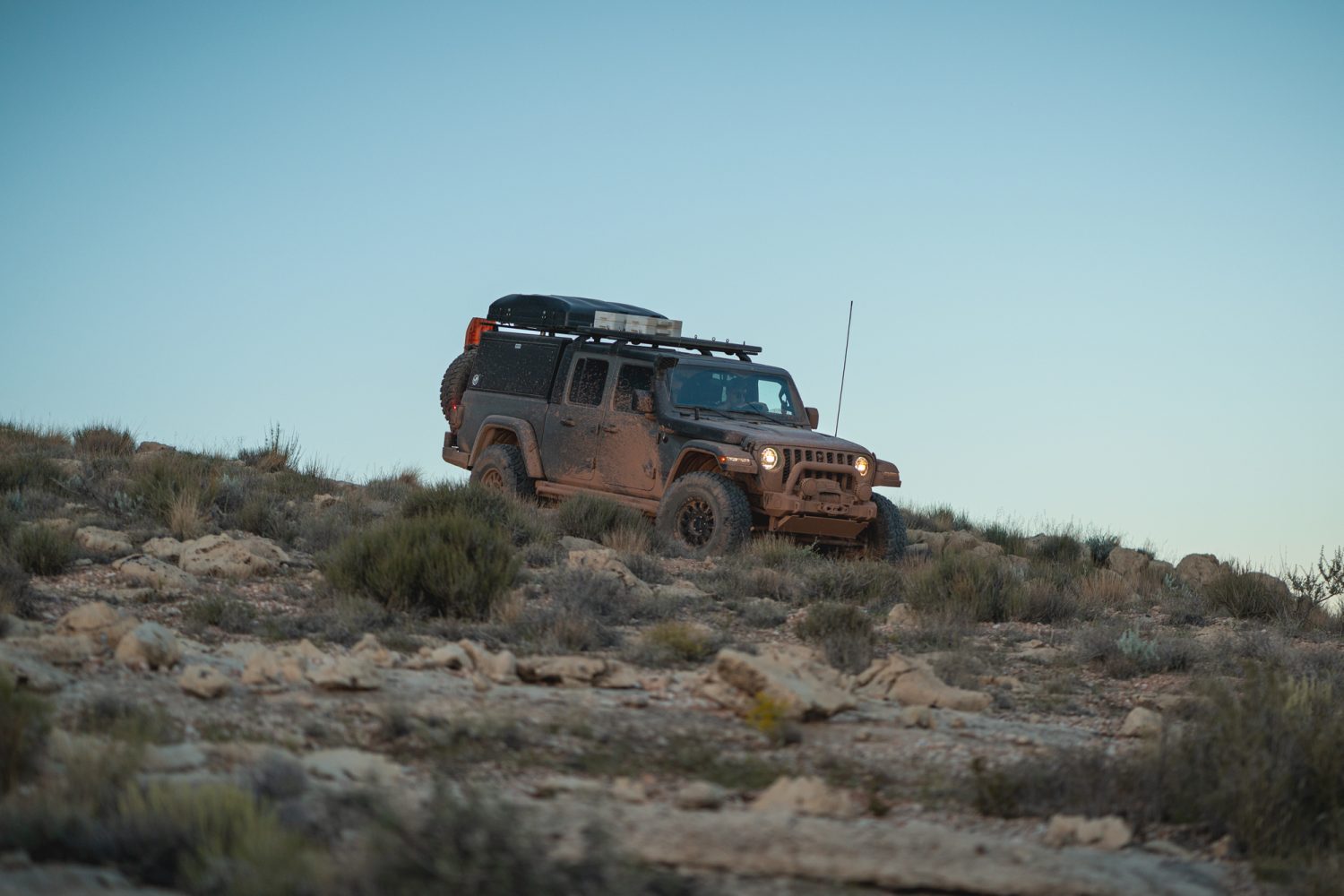
Built Jeep Gladiator descending some open desert terrain.
We bumble our way down the trail, winding through tight stands of ancient juniper and pinion before getting our first glimpse of the Grand Canyon. It’s not the first time I’ve seen it myself, but I relive that original sense of awe in the eyes of our other group members. I struggle to put words to the feelings I experience in the canyon’s presence. My gaze rolls over the rim and down the vermilion walls to the billion-year-old basement rocks below. At the heart of it all, the distant muddy torrent carves its way deeper into the Earth’s crust.

Our first view of the Grand Canyon is majestic.
We press on to camp, arriving with enough light to set up a variety of rooftop and ground tents. Before we’ve even made camp, our cooking team has already launched into a flurry of food prep while simultaneously serving up appetizers and cocktails. Let it be known that while I love backpacking, the ability to haul a full kitchen setup into remote destinations is definitely winning me over at this moment. Ice-cold Moscow Mule? Don’t mind if I do.
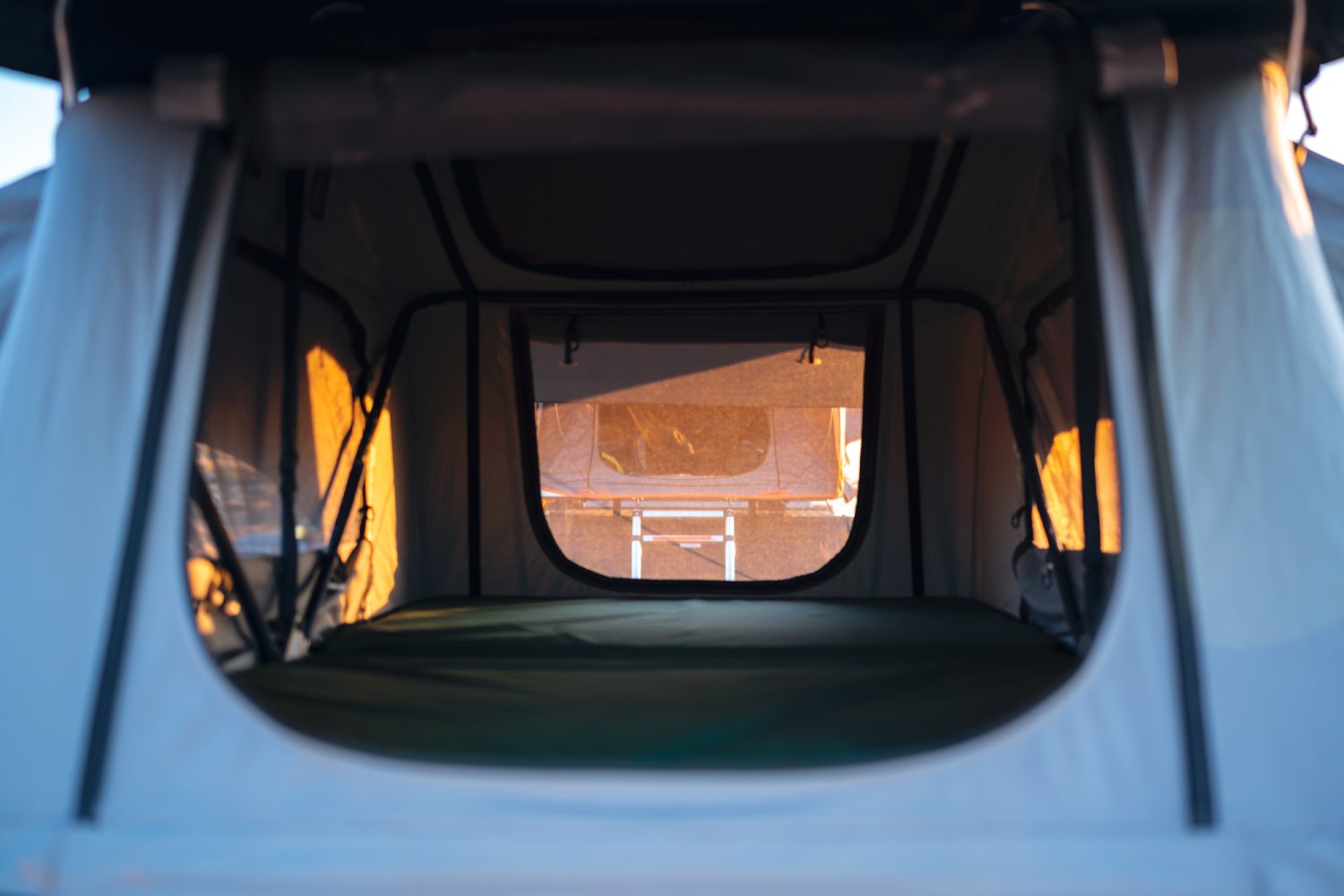
A rooftop tent is not mandatory equipment, but they are comfortable and generally better insulated than ground tents.
With a beverage in hand, I remember the promise I made to myself to pay attention to the details, and I begin exploring around our camp. In the desert, following washes—the places where water has flowed—can be a convenient way to wander. They also provide a handrail that can easily guide me back to where I began. Washes are also a great place to look for artifacts as the flowing water tends to uncover things that have been buried in the sand.
As luck would have it, I spot an incongruity in the rust-colored sand, a blood-red piece of chert half-buried in the ground. A neatly scalloped edge is the instant giveaway. Bending over to examine it closer, it becomes obvious: it’s an arrow point. After five additional minutes combing the ground, I found some large nondescript pot shards. I *bring my archeological discoveries back to camp so that the group can enjoy them as well.
*Editor’s Note: Artifacts should always be left where they are found – after photographing this arrowhead and potshards and discussing their significance with the group, the items were returned to their original resting place so that others who come along after us can enjoy them as well.
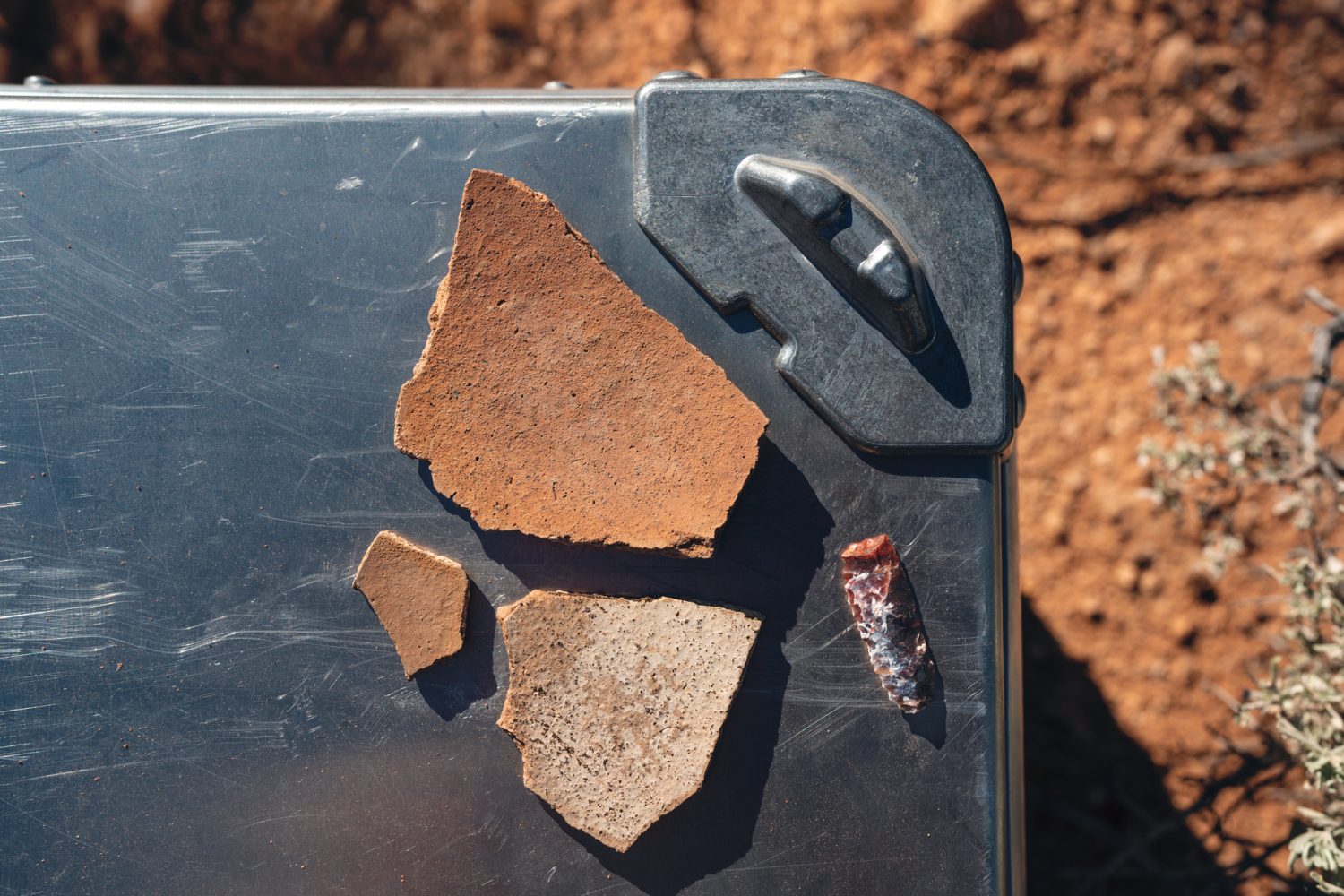
A collection of artifacts that I discovered very close to camp.
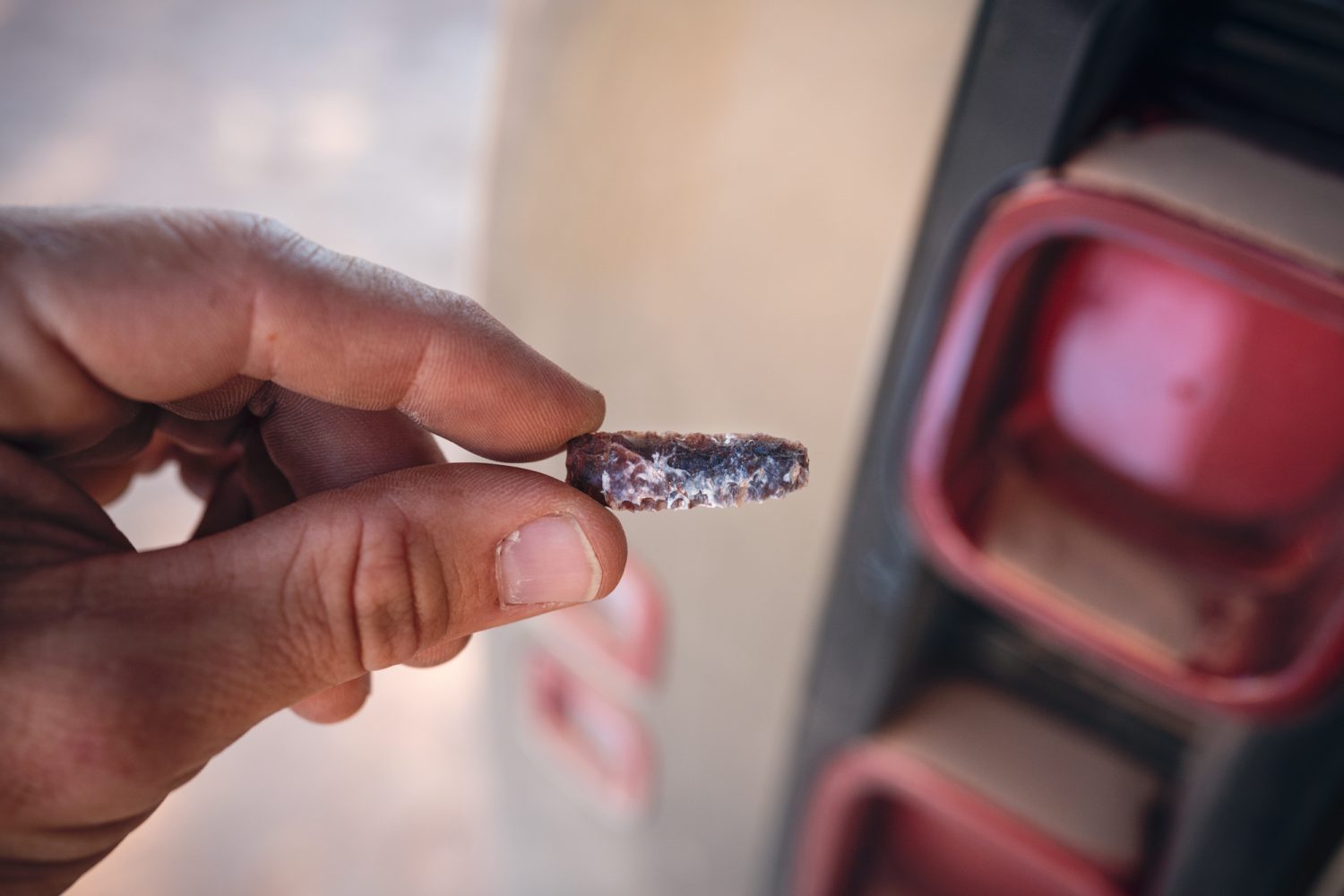
I wonder how long this has lingered in these shifting sands?
With darkness descending upon camp and the first stars rising into the evening sky, Ben asks if we want to see the moons of Jupiter, and we eagerly jump in line to have a look through his spotting scope. It turns out that those “stars” were planets, Jupiter and Saturn. Through the looking glass, we can see their distinct features in shocking detail. We joke that it’s all a hoax and ask how he managed to get the little images inside the spotting scope. We can literally see Saturn’s rings. It’s like being on a high-school field trip to the planetarium, although it’s better because adult beverages are flowing and chaperones are nowhere to be found.

Enjoying some socializing around the evening campfire. Utilize existing fire rings, don’t build new ones.
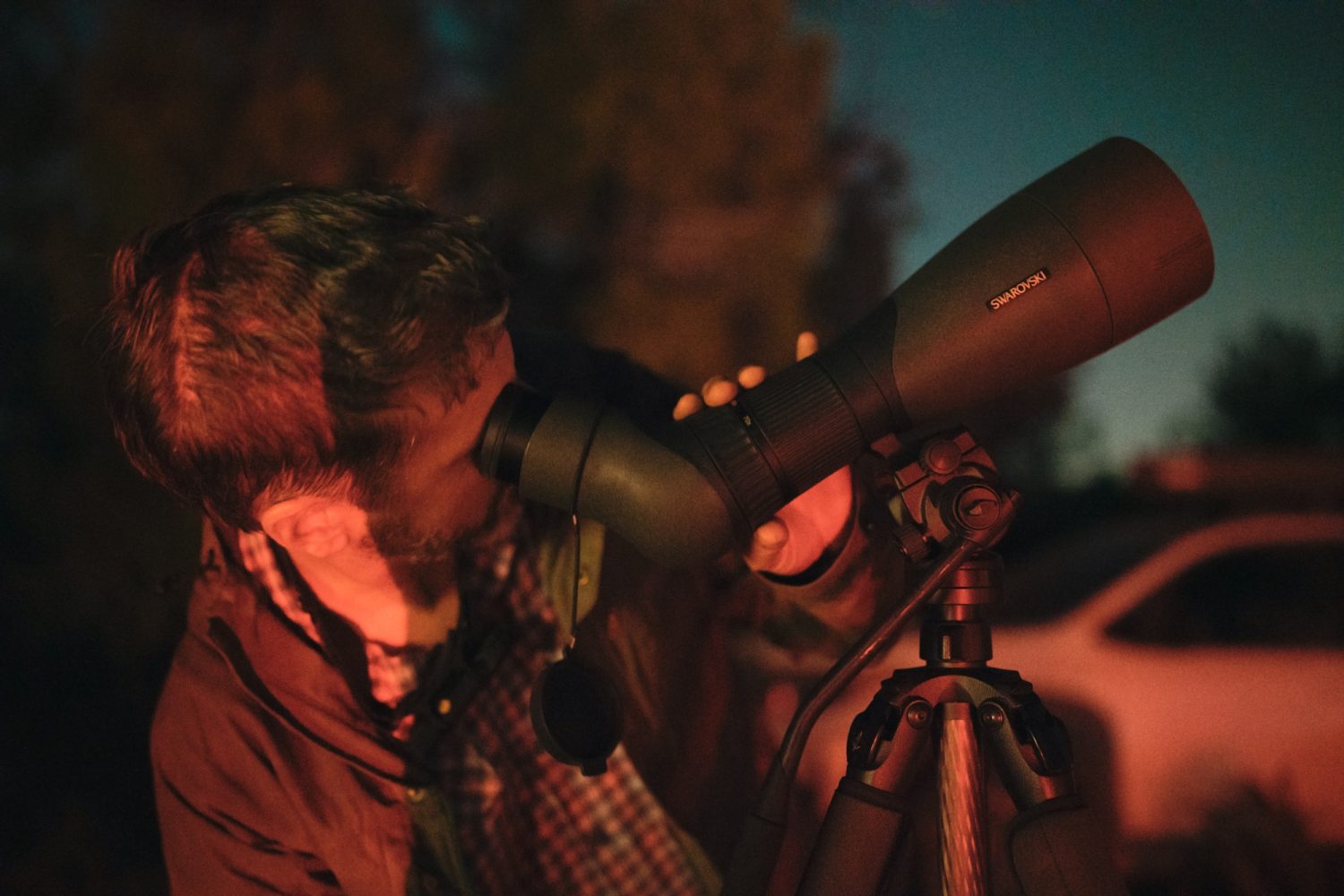
Much more compact than a telescope, I was amazed that I could see details like Jupiter’s Moons and Saturn’s Rings through this spotting scope.
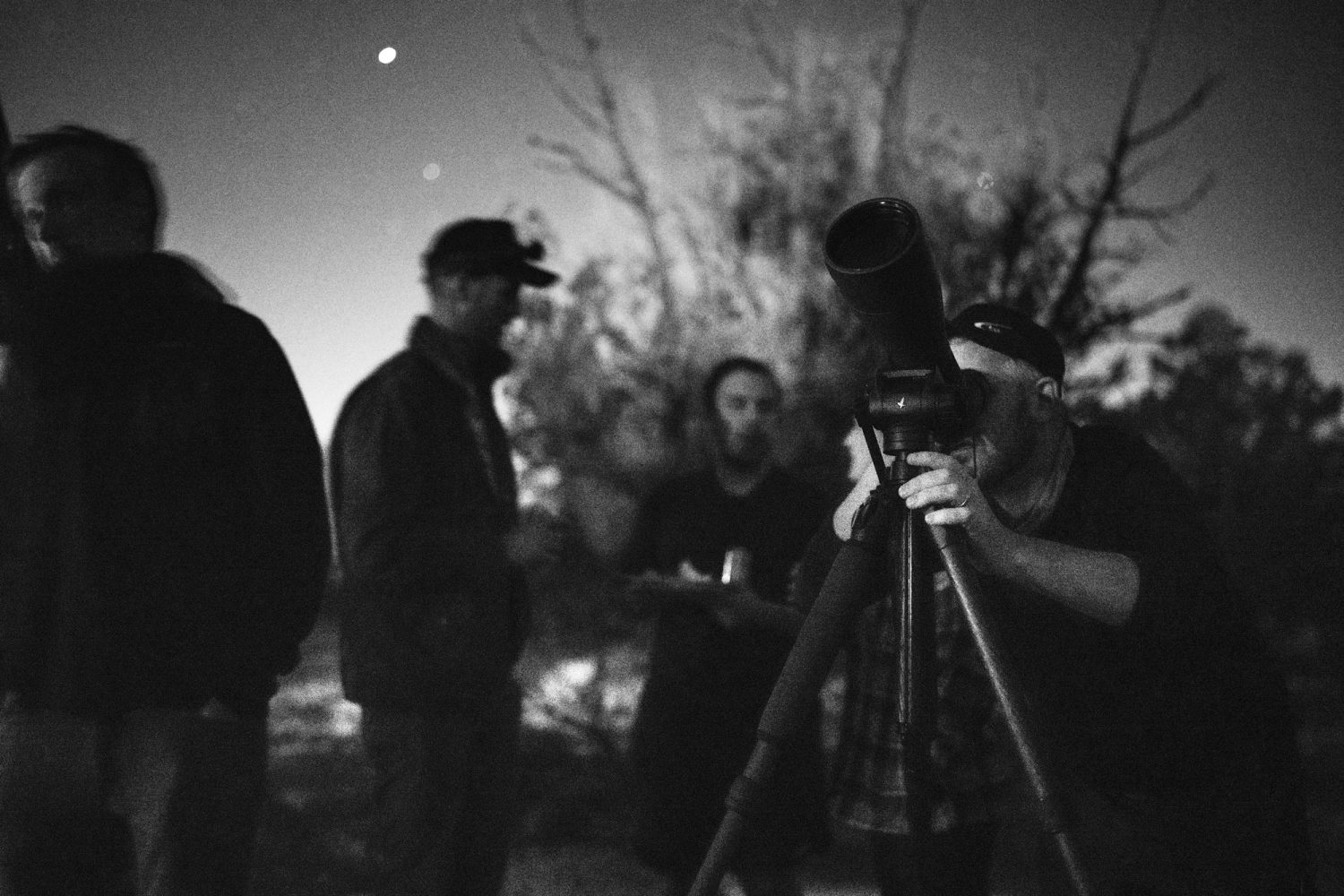
A tripod is a crucial piece of the spotting scope kit.
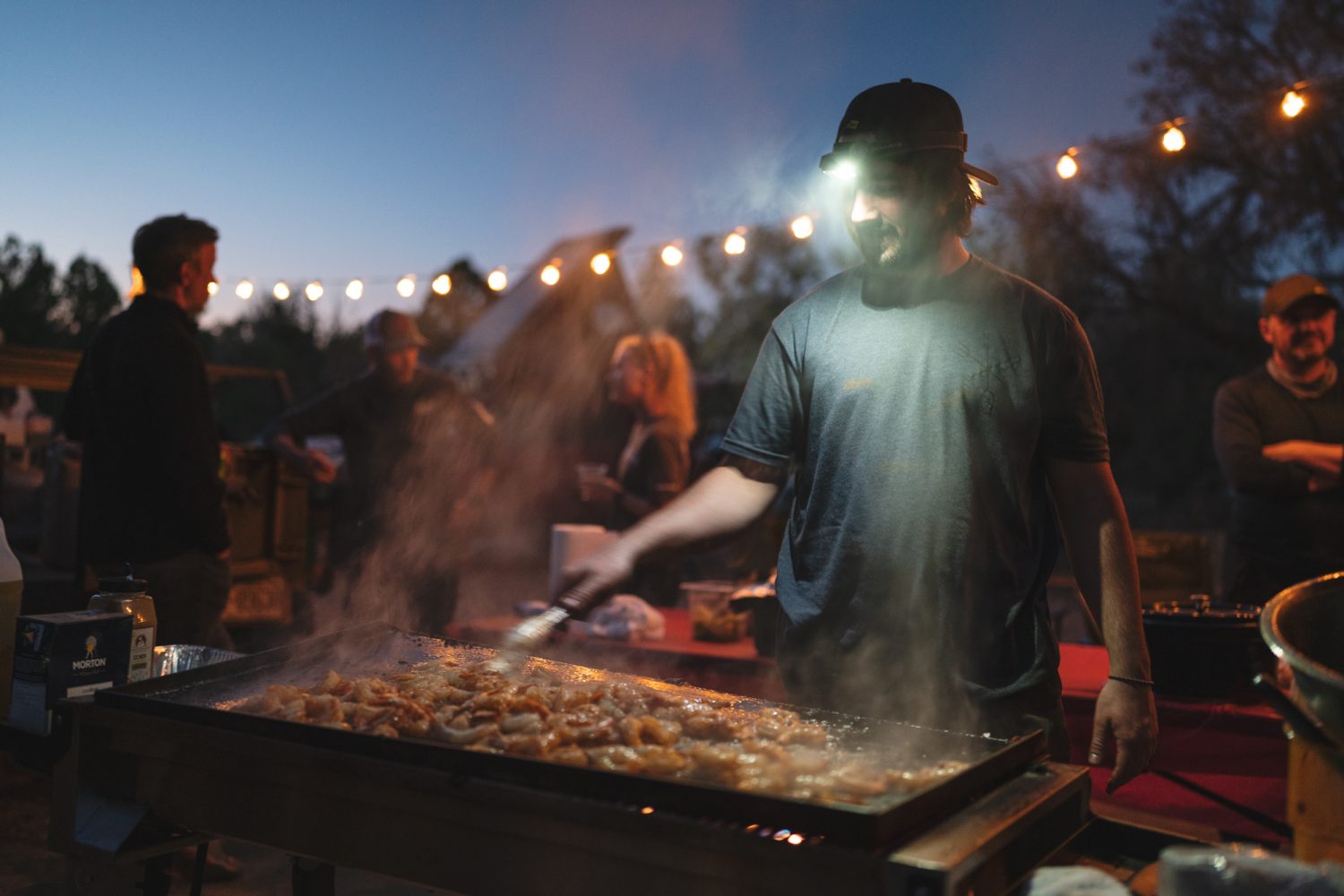
Dinner prep on the flattop grill. Overlanding affords you the ability to bring bulky items like this into the backcountry.
Eventually, after satiating our hunger with an incredible meal and after a couple more cocktails, everyone gradually disappears into their tents, tired from the trail but incredibly fulfilled from our day of exploration and discovery.
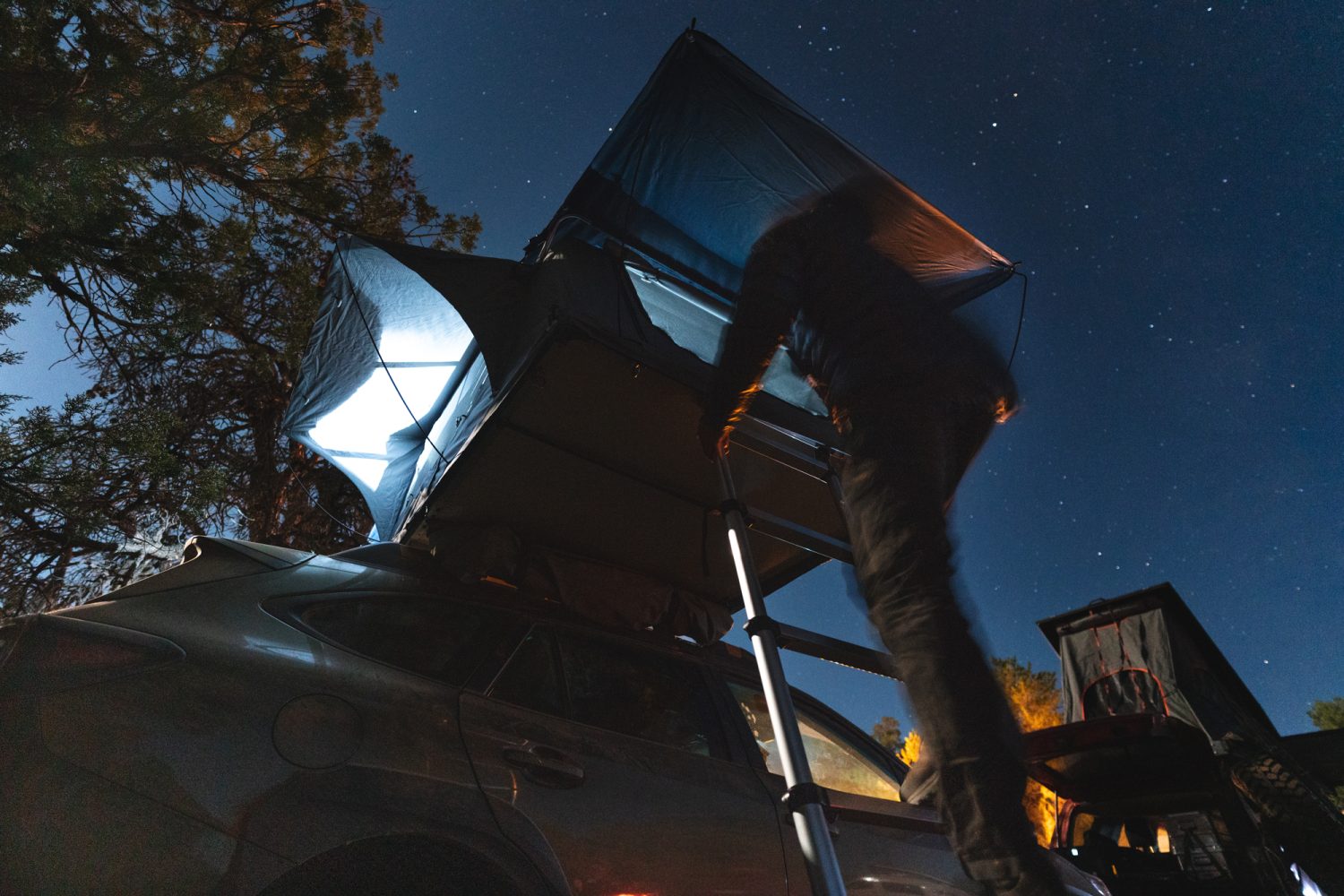
Time to retire to my evening accommodations.
Day Two on the Trail
I poke my head through the tent door and take a deep breath of the chilled morning air.

The quiet beauty of early the morning is reserved for those willing to wake up for it.
It’s 6:00 a.m., and the scents of sage and campfire, as well as early morning’s pale-blue pallet, are draped like a blanket across the high desert. Golden yellow rays trickle through the surrounding junipers creating a dappled patchwork on the chilled sand. I don’t dare disturb this calmness.
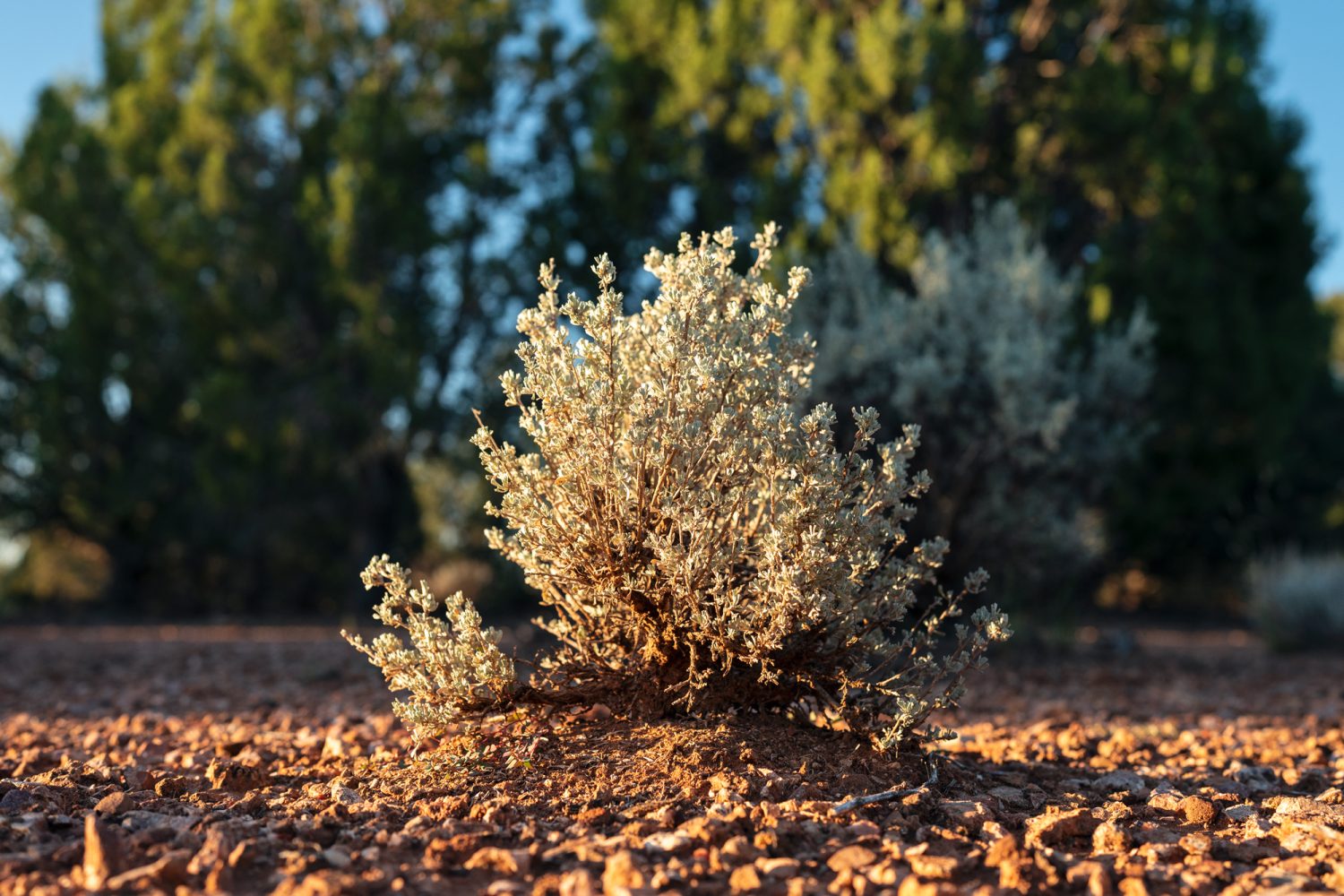
The first rays of early morning sunlight bring warmth to the chilled desert inhabitants.
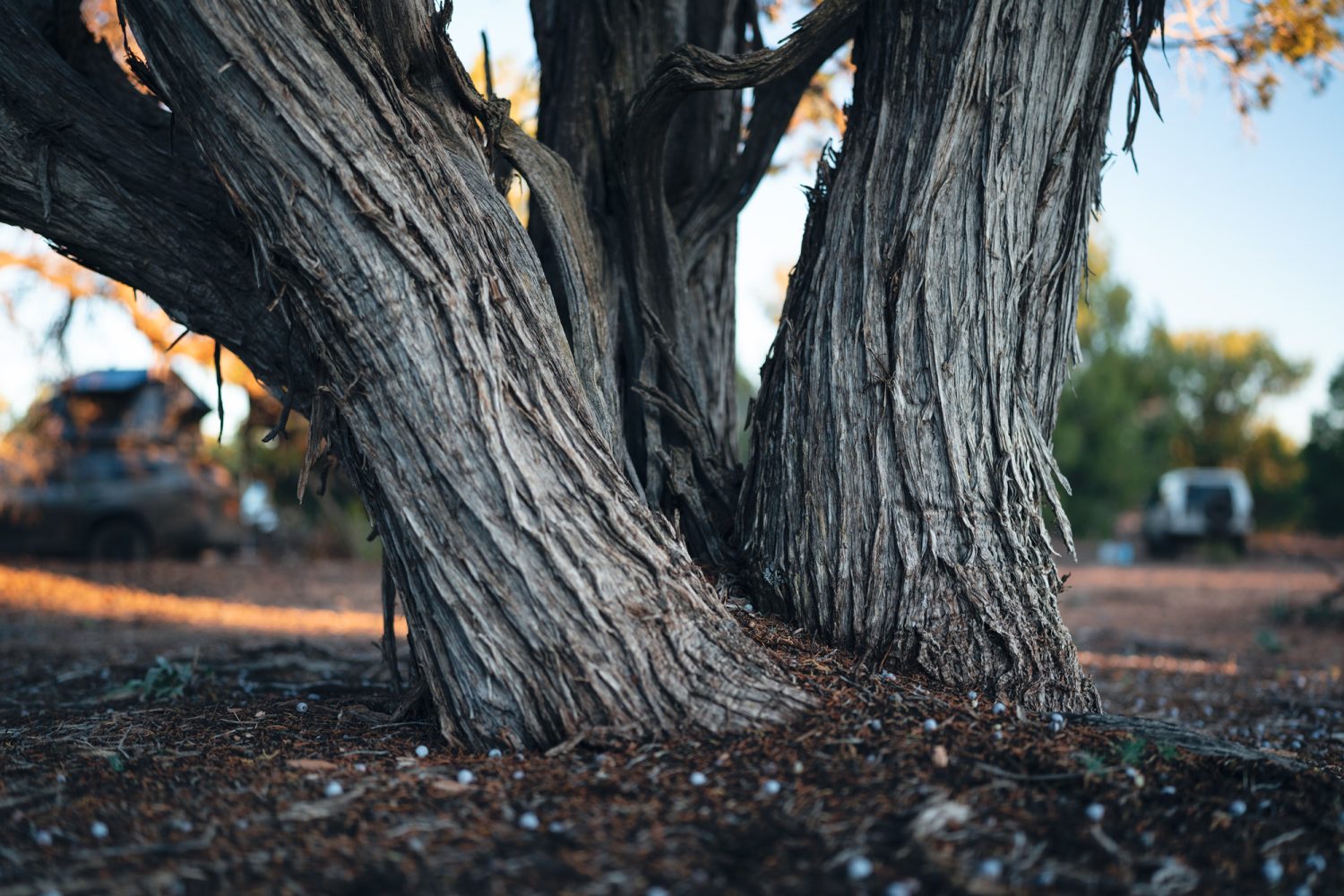


Trying to find a bird that we heard from camp. Ben identified it accurately – a woodpecker.
Coffee and breakfast tacos and packing up camp, and we’re eager to hit the trail again. I return the artifacts I discovered the previous afternoon to their original location before our wheels start turning. We traverse more trails before hitting a significant stretch of the highway en route to our next campsite. It’s only been one day in the field, and already this civilized road seems a bit more foreign.
The lunch hour passes, and we’re back on the trail, immediately encountering a 50-yard-long section of mud with standing water. There is no alternative route, and because the best practice is to remain on the trail instead of driving around the obstacle, we take turns going through. To avoid getting bogged down in the middle and becoming stuck, it’s advantageous to carry some speed. Some modulate better than others.

Finding the right balance of speed to avoid getting stuck. We may have been a little overzealous.
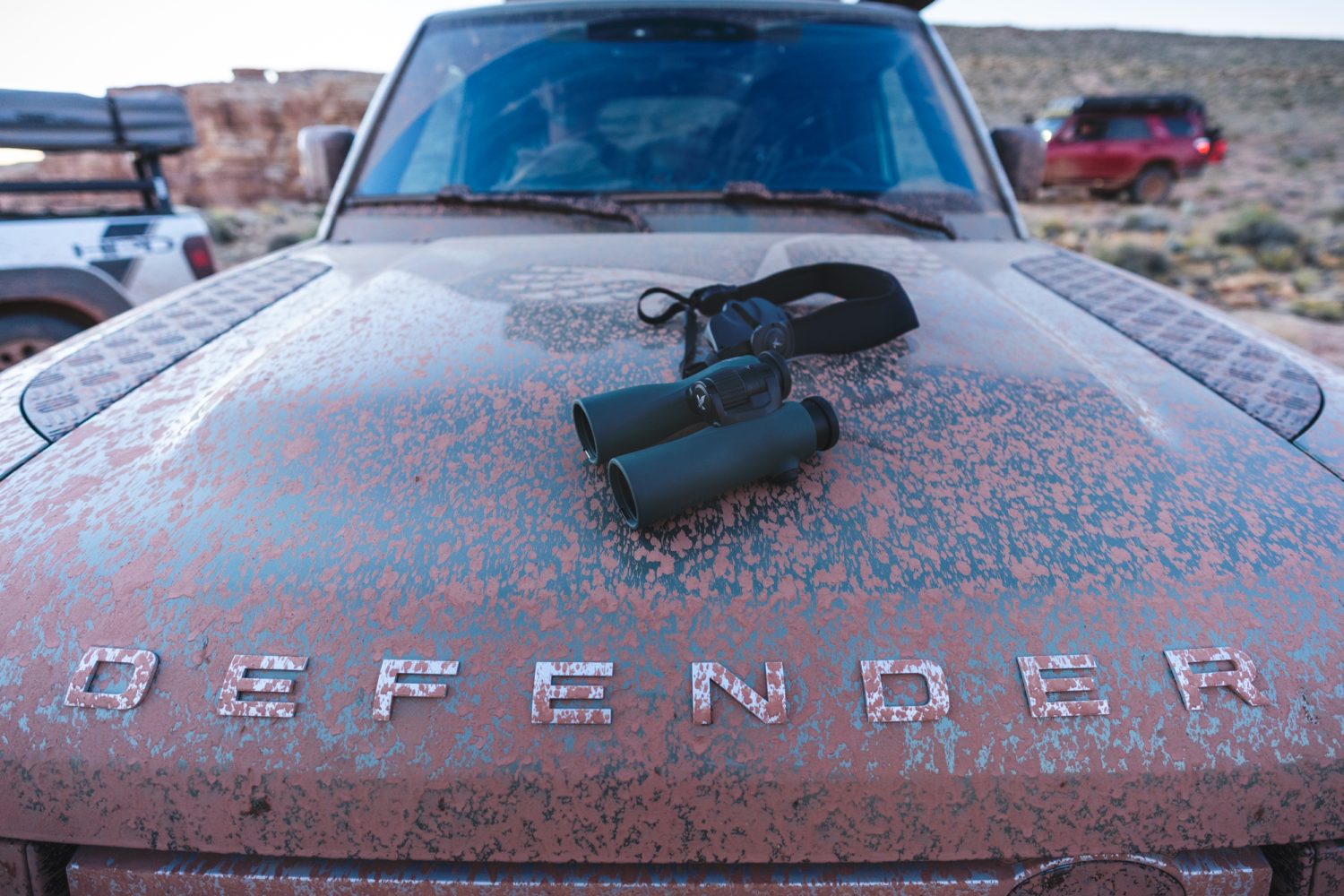
The result.
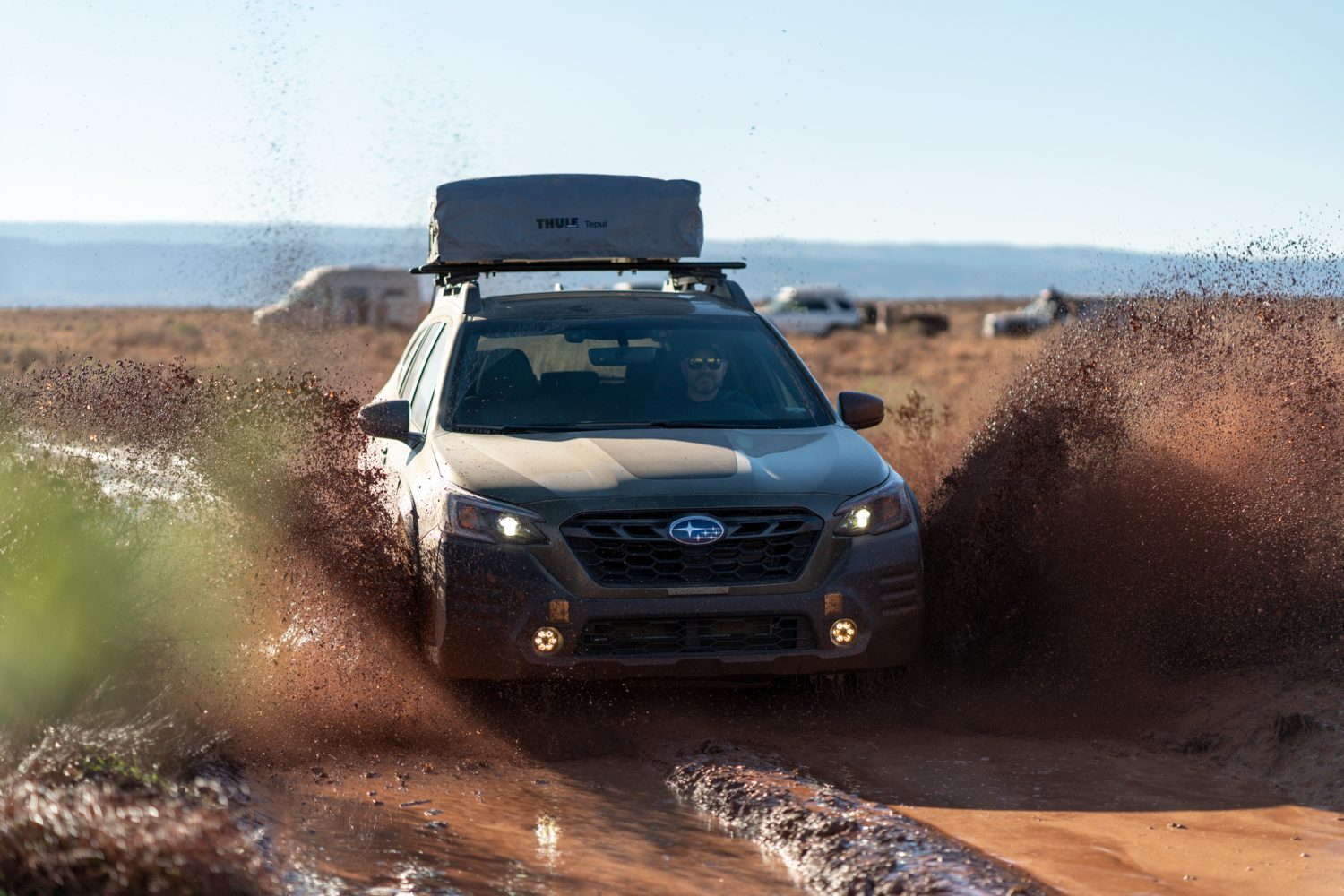
While the primary focus on this trip wasn’t about finding challenging sections of trail, we encounter some of the most technical driving in the final miles before camp. I am impressed that our eclectic mix of vehicles, from the Subaru to the Sprinter, manages to roll through without too much difficulty.
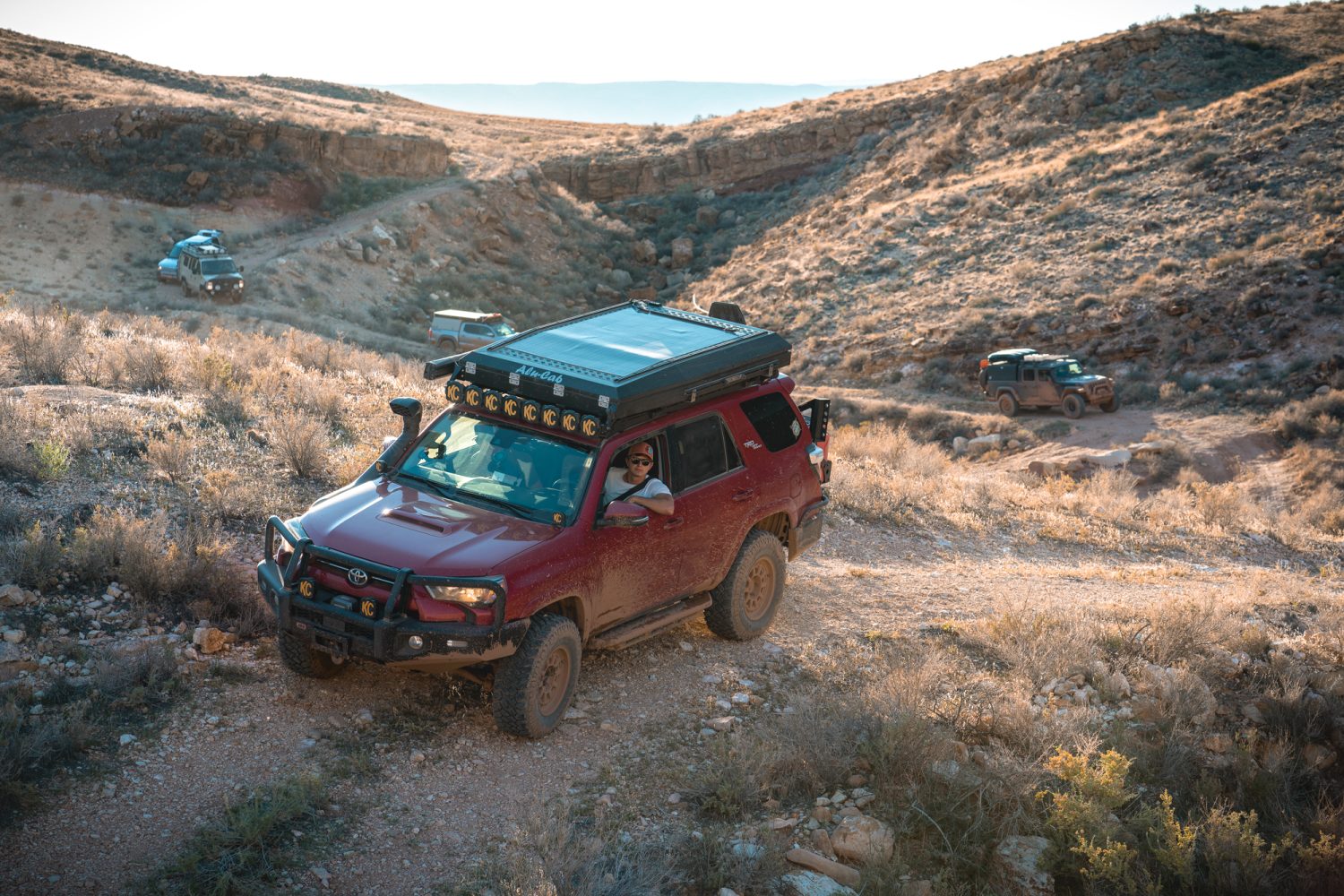
Our convoy approaches camp on the North Rim of the Grand Canyon.

The Fieldvan 4×4 Sprinter giving us a show.
Winding across the final miles of open terrain to our campsite, I’m wondering why I don’t see the North Rim yet. It’s not exactly a small feature, nor is it the kind of terrain that you would expect to unexpectedly stumble upon. But the horizon has been playing a sneaky trick on us. Out of nowhere, we’re driving along the edge of an incredible precipice. And you can see the excitement in each drivers’ eyes.
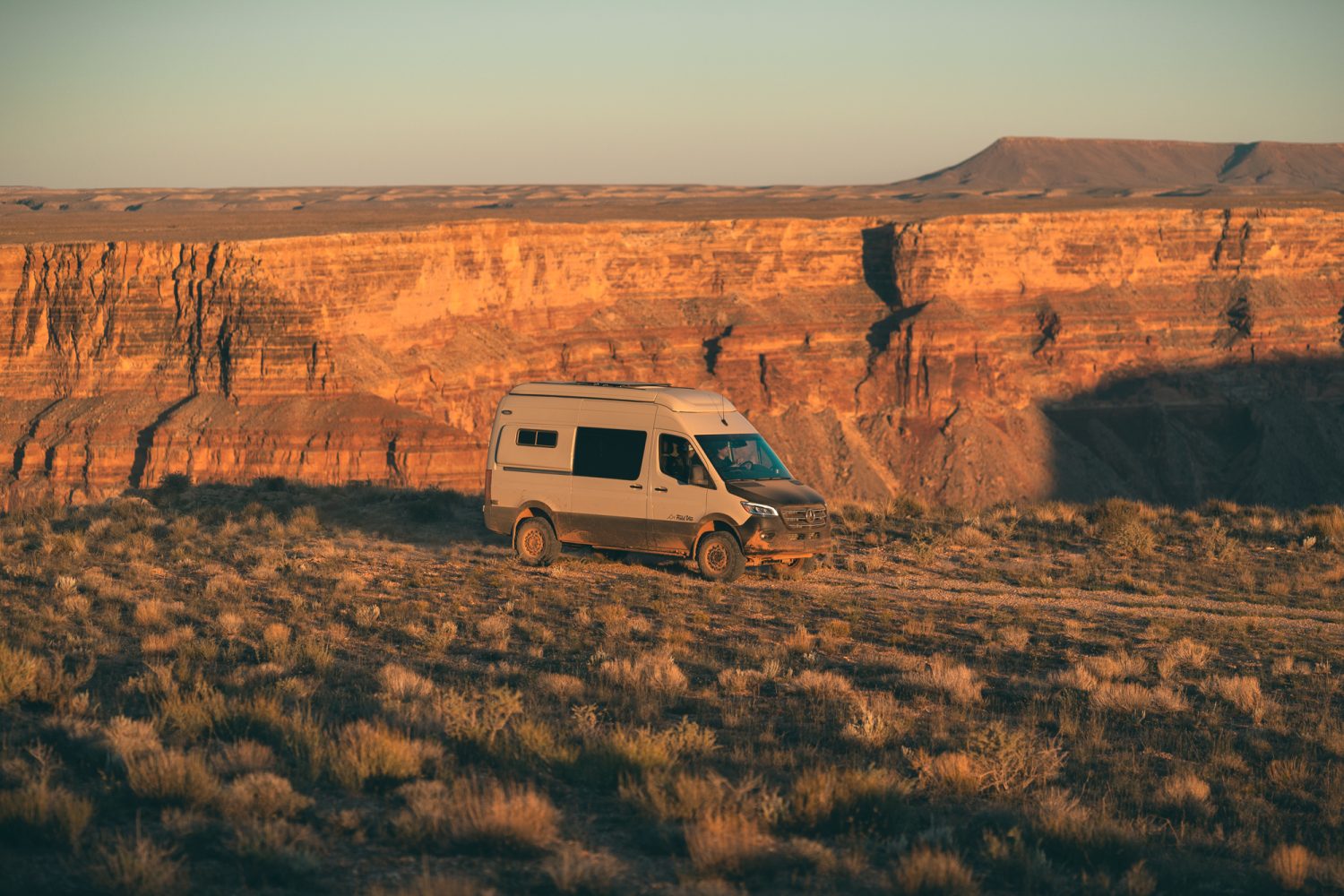

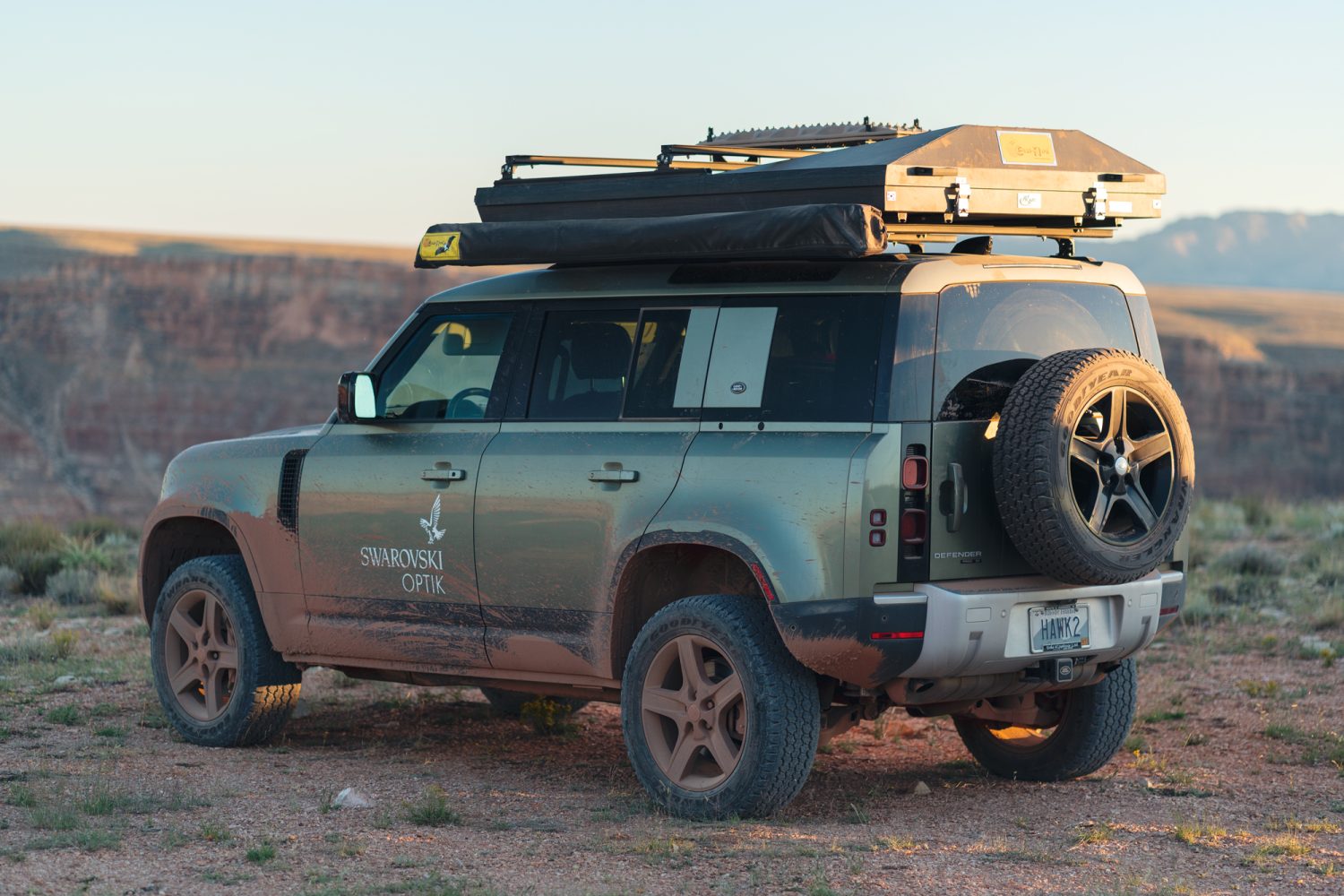
After parking and exiting our vehicles, the group’s excitement is palpable. The lazy afternoon sun is hanging low in the sky, casting dramatic shadows across the sharp white limestone at the rim. I snap a series of photographs to assemble into a panoramic shot, but I’m convinced no image could reproduce the grandeur unfolding before my eyes.

One of the best Grand Canyon overlooks I’ve found yet.
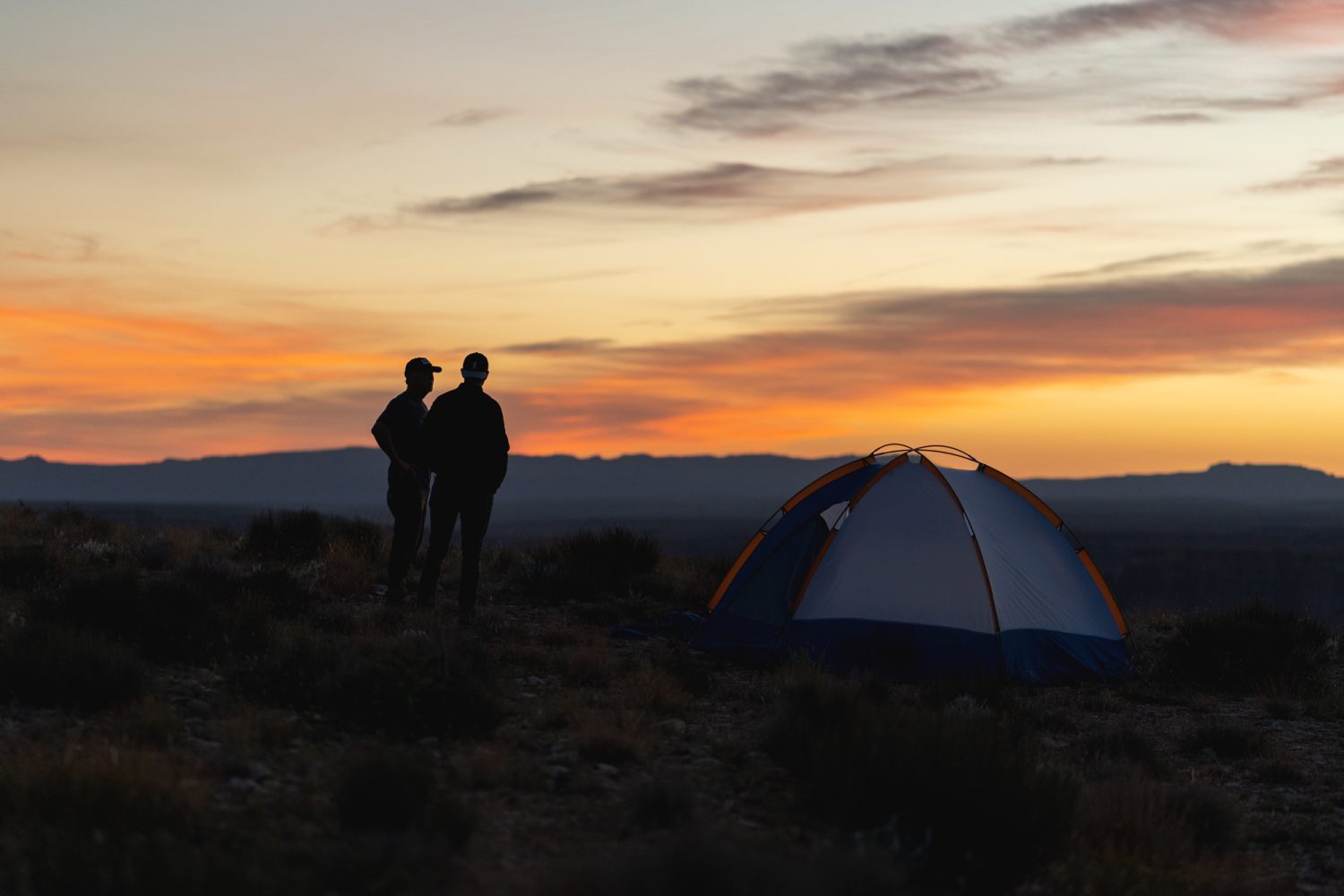
A ground tent is just as functional as a rooftop tent. The experience is our primary objective, the gear should there to support our endeavor.
And that’s what I’ve taken away from this adventure. You’ve got to get out there and actually do it. Not read about it, not watch a video, not flip through a photo album. You need to have tangible experiences in wild places. And I don’t care how you get there, whether it’s by bicycle, kayak, or overland vehicle. Just go. Smell the smells, take in the distant and detailed sights, and listen to the sound of the wind in the company of friends. Over time, just as the mighty Colorado River has carved its way into the heart of this landscape, nature will work its way into yours.


